Installing Using Anaconda
This chapter provides step-by-step instructions for installing Fedora using the Anaconda installer. The bulk of this chapter describes installation using the graphical user interface. A text mode is also available for systems with no graphical display, but this mode is limited in certain aspects (for example, custom partitioning is not possible in text mode).
If your system does not have the ability to use the graphical mode, you can:
-
Use Kickstart to automate the installation as described in Automating the Installation with Kickstart
-
Perform the graphical installation remotely by connecting to the installation system from another computer with a graphical display using the VNC (Virtual Network Computing) protocol - see Installing Using VNC
Introduction to Anaconda
The Fedora installer, Anaconda, is different from most other operating system installation programs due to its parallel nature. Most installers follow a fixed path: you must choose your language first, then you configure network, then installation type, then partitioning, etc. There is usually only one way to proceed at any given time.
In Anaconda you are only required to select your language and locale first, and then you are presented with a central screen, where you can configure most aspects of the installation in any order you like. This does not apply to all parts of the installation process, however - for example, when installing from a network location, you must configure the network before you can select which packages to install.
Some screens will be automatically configured depending on your hardware and the type of media you used to start the installation. You can still change the detected settings in any screen. Screens which have not been automatically configured, and therefore require your attention before you begin the installation, are marked by an exclamation mark. You can not start the actual installation process before you finish configuring these settings.
Additional differences appear in certain screens; notably the custom partitioning process is very different from other Linux distributions. These differences are described in each screen’s subsection.
Consoles and Logging During the Installation
The following sections describe how to access logs and an interactive shell during the installation. This is useful when troubleshooting problems, but should not be necessary in most cases.
Accessing Consoles
The Fedora installer uses the tmux terminal multiplexer to display and control several windows you can use in addition to the main interface. Each of these windows serves a different purpose - they display several different logs, which can be used to troubleshoot any issues during the installation, and one of the windows provides an interactive shell prompt with root privileges, unless this prompt was specifically disabled using a boot option or a Kickstart command.
|
In general, there is no reason to leave the default graphical installation environment unless you need to diagnose an installation problem. |
The terminal multiplexer is running in virtual console 1. To switch from the actual installation environment to tmux, press Ctrl+Alt+F1. To go back to the main installation interface which runs in virtual console 6, press Ctrl+Alt+F6.
|
If you choose text mode installation, you will start in virtual console 1 (tmux), and switching to console 6 will open a shell prompt instead of a graphical interface. |
The console running tmux has 5 available windows; their contents are described in the table below, along with keyboard shortcuts used to access them. Note that the keyboard shortcuts are two-part: first press Ctrl+b, then release both keys, and press the number key for the window you want to use.
You can also use Ctrl+b n and Ctrl+b p to switch to the next or previous tmux window, respectively.
| Shortcut | Contents |
|---|---|
Ctrl+b 1 |
Main installation program window. Contains text-based prompts (during text mode installation or if you use VNC direct mode), and also some debugging information. |
Ctrl+b 2 |
Interactive shell prompt with |
Ctrl+b 3 |
Installation log; displays messages stored in |
Ctrl+b 4 |
Storage log; displays messages related storage devices from kernel and system services, stored in |
Ctrl+b 5 |
Program log; displays messages from other system utilities, stored in |
In addition to displaying diagnostic information in tmux windows, Anaconda also generates several log files, which can be transferred from the installation system. These log files are described in Log Files Generated During the Installation, and directions for transferring them from the installation system are available in Transferring Log Files from the Installation System.
Saving Screenshots
You can press Shift+Print Screen at any time during the graphical installation to capture the current screen. These screenshots are saved to /tmp/anaconda-screenshots.
Additionally, you can use the autostep --autoscreenshot command in a Kickstart file to capture and save each step of the installation automatically. See autostep (optional) - Go Through Every Screen for details.
Installing in Text Mode
Text mode installation offers an interactive, non-graphical interface for installing Fedora. This may be useful on systems with no graphical capabilities; however, you should always consider the available alternatives before starting a text-based installation. Text mode is limited in the amount of choices you can make during the installation.
There are two alternatives to text mode which can both be used even if the installation system does not have a graphical display. You can either connect to the installation system using VNC and perform an interactive graphical installation remotely (see Installing Using VNC), or you can create a Kickstart file to perform the installation automatically (see Automating the Installation with Kickstart).
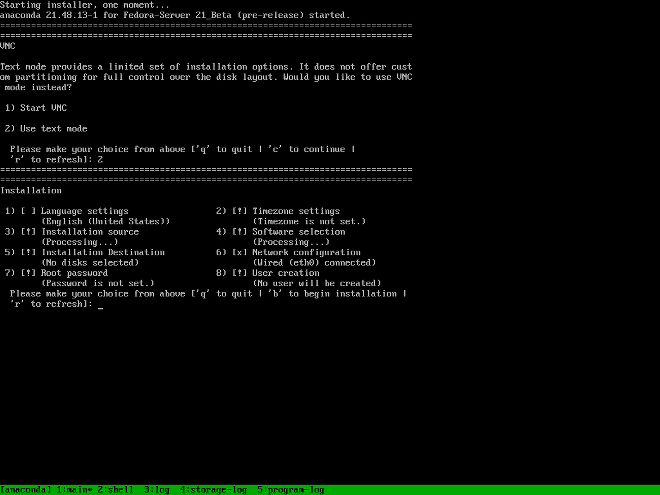
Installation in text mode follows a pattern similar to the graphical installation: There is no single fixed progression; you can configure many settings in any order you want using the main status screen. Screens which have already been configured, either automatically or by you, are marked as [x], and screens which require your attention before the installation can begin are marked with [!]. Available commands are displayed below the list of available options.
Limits of interactive text mode installation include:
-
The installer will always use the English language and the US English keyboard layout. You can configure your language and keyboard settings, but these settings will only apply to the installed system, not to the installation.
-
You can not configure any advanced storage methods (LVM, software RAID, FCoE, zFCP and iSCSI).
-
It is not possible to configure custom partitioning; you must use one of the automatic partitioning settings. You also cannot configure where the boot loader will be installed.
To start a text mode installation, boot the installation with the inst.text boot option used either at the boot command line in the boot menu, or in your PXE server configuration. See Booting the Installation for information about booting and using boot options.
Installing in the Graphical User Interface
The graphical installation interface is the preferred method of manually installing Fedora. It allows you full control over all available settings, including custom partitioning and advanced storage configuration, and it is also localized to many languages other than English, allowing you to perform the entire installation in a different language. The graphical mode is used by default when you boot the system from local media (a CD, DVD or a USB flash drive).
The sections below discuss each screen available in the installation process. Note that due to the installer’s parallel nature, most of the screens do not have to be completed in the order in which they are described here.
Each screen in the graphical interface contains a Help button. This button opens the Yelp help browser displaying the section of the Fedora Installation Guide relevant to the current screen.
You can also control the graphical installer with your keyboard. Use Tab and Shift+Tab to cycle through active control elements (buttons, check boxes, etc.) on the current screen, Up and Down arrow keys to scroll through lists, and Left and Right to scroll through horizontal toolbars or table entries. Space or Enter can be used to select or remove a highlighted item from selection and to expand and collapse drop-down menus.
Additionally, elements in each screen can be toggled using their respective shortcuts. These shortcuts are highlighted (underlined) when you hold down the Alt key; to toggle that element, press Alt+X, where X is the highlighted letter.
Your current keyboard layout is displayed in the top right hand corner. Only one layout is configured by default; if you configure more than layout in the Keyboard Layout screen (Keyboard Layout), you can switch between them by clicking the layout indicator.
Hoş Geldiniz Ekranı ve Dil Seçimi
Grafiksel kurucu başladıktan hemen sonra görüntülenen ilk ekran Hoş Geldiniz ekranıdır.

İlk olarak, sol taraftaki sütundan tercih ettiğiniz dili seçin ve ardından sağ taraftaki sütundan yerel ayarınızı seçin. Dilinizi aramak için 70’ten fazla dilin tam listesine bakmak yerine sol alt köşedeki metin giriş alanını kullanabilirsiniz.
Bu ekranda seçtiğiniz dil kurulum sırasında, ayrıca öntanımlı olarak kurulu sistemde kullanılacaktır. Kurulu sistemin dilini daha sonra değiştirebilirsiniz, ancak bu ekranda Devam Et düğmesini tıkladığınızda, geri dönüp kurucunun içinde kullanılan dili değiştiremezsiniz.
Listenin başında öntanımlı olarak bir dil seçilidir. Ağ erişimi bu noktada yapılandırılmışsa (örneğin, yerel ortam yerine bir ağ sunucusundan önyükleme yaptıysanız), önceden seçilen dil, GeoIP modülü kullanılarak otomatik konum algılamaya göre belirlenir. Alternatif olarak, önyükleme komut satırında veya PXE sunucu yapılandırmanızda inst.lang= seçeneğini kullandıysanız, bu dil öntanımlı olarak seçilecektir, ancak yine de değiştirebilirsiniz.
Dilinizi ve yerel ayarınızı seçtikten sonra, seçiminizi onaylamak ve Kurulum Özetine geçmek için Devam düğmesine tıklayın.
|
Bir Fedora ön sürümünü kuruyorsanız, |
Installation Summary
The Installation Summary screen is the central location for setting up an installation. Most of the options which can be configured during the installation can be accessed from here.
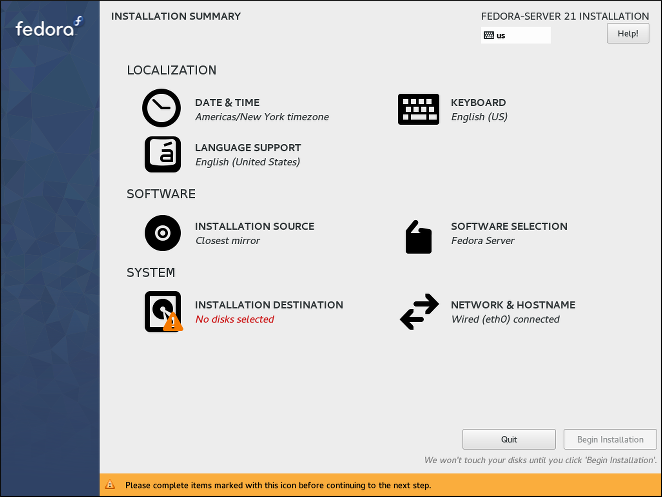
|
If you used a Kickstart option or a boot option to specify an installation repository on a network, but no network is available at the start of the installation, the installer will display the |
The summary screen consists of several links to other screens, separated into categories. These links can be in several different states, which are graphically indicated:
-
A warning symbol (yellow triangle with an exclamation mark) next to an icon means that a screen requires your attention before you start the installation. This typically happens with the
Installation Destinationscreen, because even though there is a default automatic partitioning variant, you always have to at least confirm this selection, even if you do not want to make any changes. -
If a link is greyed out, it means that the installer is currently configuring this section, and you must wait for the configuration to finish before accessing that screen. This typically happens when you change the installation source in the
Installation Sourcescreen and the installer is probing the new source location and gathering a list of available packages. -
Screens with black text and no warning symbol mean that this screen does not require your attention. You can still change your settings in these screens, but it is not necessary to do so to complete the installation. This typically happens with localization settings, as these are either detected automatically, or set up on the previous screen where you select your language and locale.
A warning message is displayed at the bottom of the summary screen, and the Begin Installation button is greyed out, as long as at least one item has not been configured yet.

Each screen also has an explanatory text below its title, showing settings currently configured in that screen. This text may be concatenated; in that case, move your mouse cursor over it and wait until a tooltip with the full text appears.

Once you configure everything required for the installation, you can press the Begin Installation button to start installing Fedora. This will take you to Configuration and Installation Progress. Note that as the text below this button says, nothing will be written to your hard drive before you press this button. You can press Quit at any point; this will discard all changes you made in the installer so far and reboot the system.
Date & Time
The Date & Time screen allows you to configure time and date-related settings for your system. This screen is automatically configured based on the settings you selected in Welcome Screen and Language Selection, but you can change your date, time and location settings before you begin the installation.
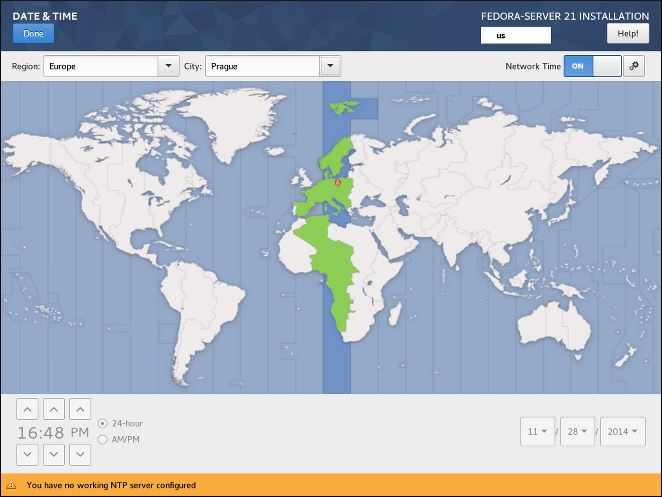
First, select your Region using the drop-down menu in the top left corner of the screen. Then, select your City, or the city closest to your location in the same time zone. Selecting a specific location helps Fedora ensure that your time is always set correctly including automatic time changes for daylight savings time if applicable.
You can also select a time zone relative to Greenwich Mean Time (GMT) without setting your location to a specific region. To do so, select Etc as your region.
|
The list of cities and regions comes from the Time Zone Database (tzdata) public domain, which is maintained by the Internet Assigned Numbers Authority (IANA). The Fedora Project can not add cities or regions into this database. You can find more information at the IANA official website. |
The switch labeled Network Time in the top right corner of the screen can be used to enable or disable network time synchronization using the Network Time Protocol (NTP). Enabling this option will keep your system time correct as long as the system can access the internet. By default, four NTP pools are configured; you can add others and disable or remove the default ones by clicking the gear wheel button next to the switch.
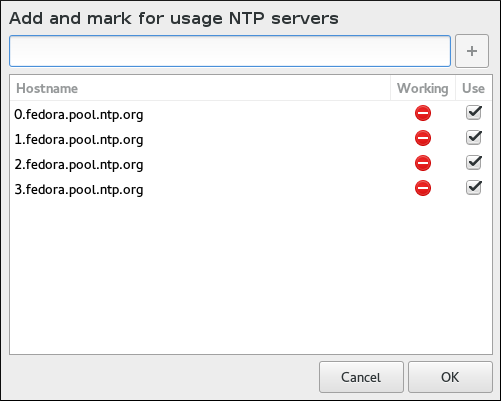
If you disable network time synchronization, the controls at the bottom of the screen will become active, and you will be able to set the current time and date manually.
After configuring your time and date settings, press the Done button in the top left corner to return to Installation Summary.
Klavye Düzeni
Klavye Düzeni ekranı, sisteminiz için bir veya daha fazla klavye düzeni ayarlamanıza ve bunlar arasında geçiş yapmanıza olanak tanımaktadır. Hoş Geldiniz Ekranı ve Dil Seçimi bölümündeki seçiminize göre bir klavye düzeni otomatik olarak yapılandırılır, ancak bu düzeni değiştirebilir ve kuruluma başlamadan önce başka düzenler ekleyebilirsiniz.
Klavye düzenleri sistem dillerinden ayrı bir ayardır ve bu iki ayarı uygun gördüğünüz şekilde karıştırabilirsiniz.
|
Bu ekranda yapılandırılan tüm ayarlar kurulu sistemde kullanılabilir olacak ve kurucunun içinde de hemen kullanılabilecektir. Yapılandırılmış düzenleriniz arasında geçiş yapmak için herhangi bir ekranın sağ üst köşesindeki klavye simgesini veya bu ekranda yapılandırdığınız klavye geçiş anahtarını kullanabilirsiniz. |
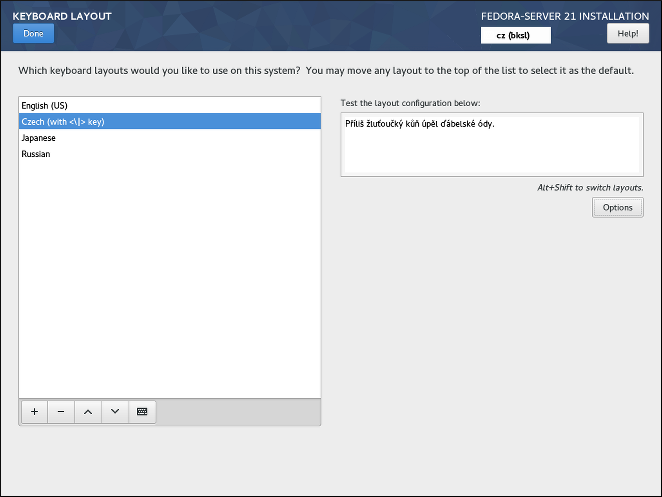
Ekranın sol yarısı, yapılandırılmış tüm düzenleri listeleyen bir pencere içerir. Düzenlerin görüntülenme sırası önemlidir - düzenler arasında geçiş yapılırken aynı sıra kullanılacaktır ve listelenen ilk düzen sisteminizde öntanımlı olacaktır.
Ekranın sağ tarafındaki metin alanı seçili olan düzeni test etmek için kullanılabilir.
Listedeki bir düzeni vurgulamak için üzerine tıklayabilirsiniz. Listenin altında bir dizi düğme vardır:
-
+düğmesi yeni bir düzen ekler. Bu düğmeye bastığınızda, dile göre gruplandırılmış kullanılabilir tüm düzenlerin listesini içeren yeni bir pencere açılır. Listeye göz atarak bir düzen bulabilirsiniz veya bu pencerenin altındaki arama çubuğunu kullanabilirsiniz. Eklemek istediğiniz düzeni bulduğunuzda vurgulayın veEkledüğmesine basın. -
-düğmesi o anda vurgulanan düzeni kaldırır. -
Yukarı ve aşağı düğmeleri, vurgulanan düzeni listede yukarı veya aşağı taşımak için kullanılabilir.
-
Klavye düğmesi, vurgulanan düzenin görsel bir sunumunu gösteren yeni bir pencere açar.
|
|
İsteğe bağlı olarak, kullanılabilir düzenler arasında geçiş yapmak için kullanılabilecek bir klavye geçiş anahtarı da yapılandırabilirsiniz. Bunu yapmak için ekranın sağ tarafındaki Seçenekler düğmesine tıklayın. Geçiş için bir veya daha fazla tuş veya tuş dizisi yapılandırmanıza olanak tanıyan Düzen Geçişi Seçenekleri iletişim penceresi açılacaktır. Yanlarındaki onay kutularını kullanarak bir veya daha fazla tuş dizisini seçin ve seçiminizi onaylamak için Tamam düğmesine tıklayın.
Klavye düzenlerini ve geçiş anahtarlarını yapılandırmayı tamamladıktan sonra, Kurulum Özetine dönmek için sol üst köşedeki Bitti düğmesine tıklayın.
Dil Desteği
Dil Desteği ekranı, sisteminiz için dil ayarlarını yapılandırmanıza olanak tanımaktadır. Öntanımlı dil, Hoş Geldiniz Ekranı ve Dil Seçimi bölümündeki seçiminiz tarafından belirlenir ve bu dil için destek kaldırılamaz. Sadece ek diller ekleyebilirsiniz, bunlar kurulu sistemde kullanılabilir olacaktır, kurulum sırasında değil.
Öntanımlı dili veya kurulum sırasında kullanılan dili değiştirmek isterseniz, sisteminizi ve ardından kurucuyu yeniden başlatmanız ve Hoş Geldiniz Ekranı ve Dil Seçimi bölümünde farklı bir dil seçmeniz gerekmektedir.
|
Başka bir dil için destek eklemek, karşılık gelen klavye düzenini otomatik olarak yapılandırmaz. Düzenler, Klavye Düzeni bölümünde yapılandırılan ayrı bir ayardır. |

Sol panel İngilizce veya Bulgarca gibi kullanılabilir dil gruplarının bir listesini içermektedir. Bir gruptan en az bir dil seçilirse, grubun yanında bir onay işareti görüntülenir ve liste ögesi vurgulanır. Bu, hangi diller için destekleri yapılandırdığınızı kolayca görmenizi sağlar.
Bir veya daha fazla ilave dil desteği eklemek için sol panelde bir gruba tıklayın ve ardından liste ögelerinin yanındaki onay kutularını kullanarak sağ panelde bir veya daha fazla bölgesel çeşidini seçin. Desteğini kurmak istediğiniz tüm diller için bu işlemi tekrarlayın.
|
Bazı diller için desteği etkinleştirmek (genellikle Latin alfabesinden başka bir alfabe kullanan diller) ek paketler kuracaktır - örneğin, |
Seçimlerinizi yaptıktan sonra, Kurulum Özetine dönmek için sol üst köşedeki Bitti düğmesine tıklayın.
Installation Source
The Installation Source screen allows you to specify a location (local or on the network) from which packages will be downloaded and installed on your system. This screen will be configured automatically in most cases, but you can change your settings or add additional sources.
|
Normally, when you first enter the |
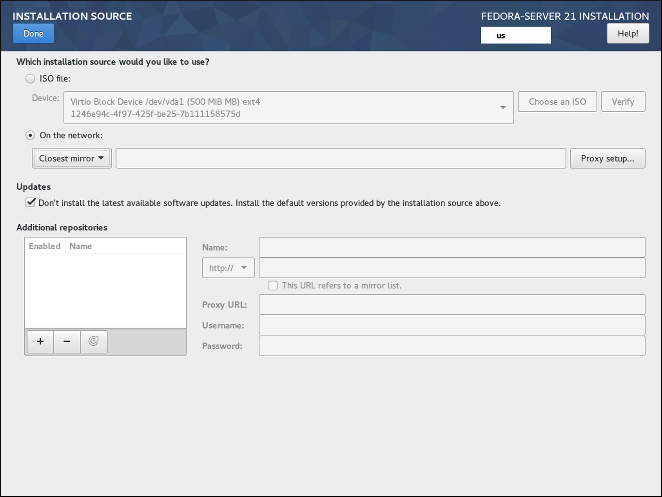
The following options are available. Note that not all of them may be displayed.
- Auto-detected installation media
-
This is the option selected by default if you started the installer from media containing an installation source, such as a live DVD. No additional configuration is necessary. You can click the
Verifybutton check the media integrity. - ISO file
-
This option will appear if the installation program detected a partitioned hard drive with mountable file systems during boot. Select this option, click the Choose an ISO button, and browse to the installation ISO file’s location on your system. You can click the
Verifybutton to check the file’s integrity. - On the network
-
Use this option to download packages to be installed from a network location instead of local media. This is the default selection on network installation media.
In most cases, the
Closest mirroroption available from the protocol selection drop-down menu is preferable. If this option is selected, packages for your system will be downloaded from the most suitable location (mirror).To manually configure a network-based installation source, use the drop-down menu to specify the protocol to be used when downloading packages. This setting depends on the server you want to use. Then, type the server address (without the protocol) into the address field. If you choose NFS, a second input field will appear where you can specify custom
NFS mount options.When selecting an NFS installation source, you must specify the address with a colon (
:) character separating the host name from the path. For example:server.example.com:/path/to/directoryTo configure a proxy for an HTTP or HTTPS source, click the Proxy setup button. Check
Enable HTTP proxyand type the URL into theProxy URLbox. If the proxy server requires authentication, checkUse Authenticationand enter your user name and password. Click OK to finish the configuration.If your HTTP or HTTPS URL refers to a repository mirror list, mark the check box under the address field.
You can also specify additional repositories in the Additional repositories section to gain access to more installation environments and software add-ons. All environments and add-ons will be available for selection in Software Selection once you finish configuring the sources.
To add a repository, click the + button. To delete a repository, select one in the list and click the - button. Click the arrow icon to revert to the previous list of repositories, i.e. to replace current entries with those that were present at the time you entered the Installation Source screen. To activate or deactivate a repository, click the check box in the Enabled column at each entry in the list.
You can name your additional repository and configure it the same way as the primary repository on the network using the input fields on the right side of the section.
Once you have selected your installation source, click Done in the top left corner to return to Installation Summary.
Yazılım Seçimi
Yazılım Seçimi ekranı bir Temel Ortam ve Eklentiler seçmenize olanak tanımaktadır. Bu seçenekler, kurulum işlemi sırasında sisteminize hangi yazılım paketlerinin kurulacağını belirlemektedir.
Bu ekran yalnızca Kurulum Kaynağı düzgün yapılandırılmışsa ve kurucu paket üst verilerini kaynaktan indirdikten sonra kullanılabilir.
|
Elle kurulum sırasında belirli paketleri seçmek mümkün değildir. Sadece önceden tanımlanmış ortamları ve eklentileri seçebilirsiniz. Tam olarak hangi paketlerin kurulacağını belirleme ihtiyacı duyuyorsanız, bir Kickstart dosyası kullanmalı ve %packages bölümünde paketleri tanımlamalısınız. Kickstart kurulumları hakkında bilgi için Kickstart ile Kurulumu Otomatikleştirme bölümüne bakın. |
Ortamların ve eklentilerin kullanılabilir olma durumu kurulum kaynağınıza bağlıdır. Öntanımlı olarak, seçimler kurulumu başlatmak için kullandığınız kurulum ortamına bağlıdır; Fedora Server kurulum kalıbında, örneğin Fedora Cloud kalıbından farklı ortamlar ve eklentiler kullanılabilir olacaktır. Farklı ortamlar içeren farklı bir kurulum kaynağı yapılandırarak bunu değiştirebilirsiniz.
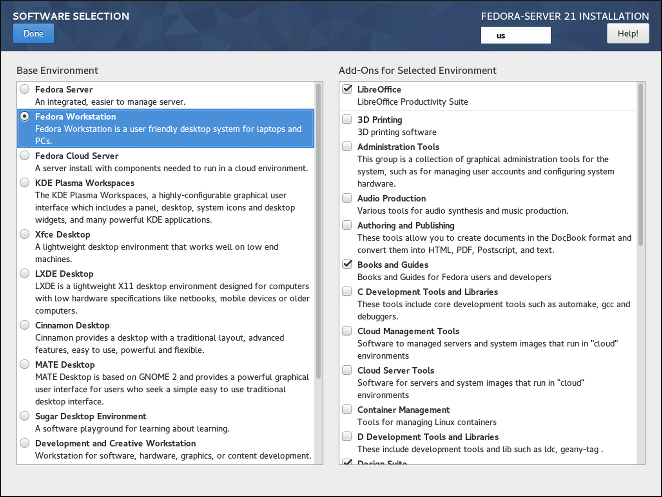
Yazılım seçiminizi yapılandırmak için önce ekranın sol tarafında bir ortam seçin. Daha fazlası kullanılabilir olsa bile yalnızca bir ortam seçilebilir. Ardından, ekranın sağ tarafında, her eklentinin yanındaki onay kutularını işaretleyerek kurmak istediğiniz bir veya daha fazla eklentiyi seçin.
Eklentilerin listesi yatay bir çizgi ile iki bölüme ayrılmıştır. Bu çizginin üzerindeki eklentiler seçtiğiniz ortamın bir parçası olarak tanımlanır; farklı bir ortam seçerseniz, burada bulunan eklentiler değişecektir. Ayırıcının altında görüntülenen eklentiler seçtiğiniz ortama özgü değildir.
Ortamlar ve eklentiler, kurulum kaynağınızdaki bir comps.xml dosyası kullanılarak tanımlanır (örneğin, tam Fedora Server kurulum DVD’sindeki repodata/ dizininde). Belirli bir ortamın veya eklentinin bir parçası olarak hangi paketlerin kurulacağını tam olarak görmek için bu dosyayı inceleyin. comps.xml dosyası hakkında daha fazla bilgi için, %packages (gerekli) - Paket Seçimi bölümüne bakın.
Yazılım seçiminizi yapılandırmayı tamamladıktan sonra, Kurulum Özetine dönmek için sol üst köşedeki Bitti düğmesine tıklayın.
Installation Destination
The Installation Destination screen allows you to configure storage options - namely, which disks will be used as the installation target for your Fedora installation. At least one disk must always be selected for the installation to proceed.
For information about the theory and concepts behind disk partitioning in Linux, see Recommended Partitioning Scheme.
|
If you plan to use a disk which already contains some data - for example, if you want to shrink an existing Microsoft Windows partition and install Fedora as a second system or if you are upgrading a previous release of Fedora, make sure to back up any important data first. Manipulating partitions always carries a risk - if the process is interrupted or fails for any reason (installer error, hardware failure, power outage, etc.), any data already on the disk may become impossible to recover. |
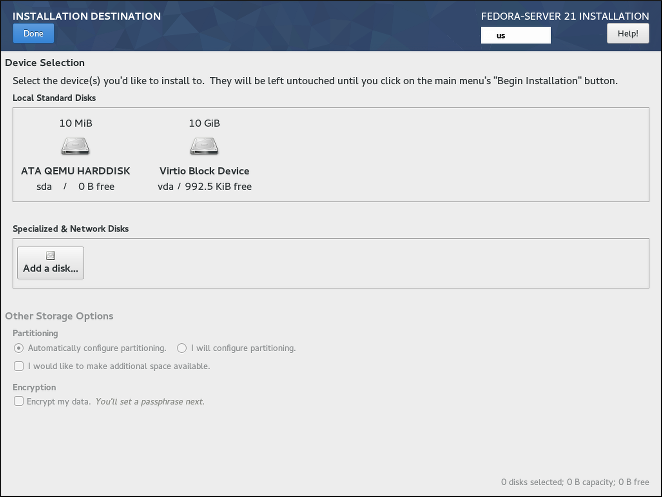
In the top part of the screen, all locally available storage devices (SATA, IDE and SCSI hard drives, USB flash drives, etc.) are displayed in the Local Standard Disks section. Local disks are detected when the installer starts - any storage devices connected after the installation has started will not be shown.
If you need to configure additional local storage devices, select I will configure partitioning and press Done to move to Manual Partitioning. Then, connect any new hard drives you want to make available during the installation, and press the button marked by a circular arrow in the set of controls below the list of mount points on the left side of the screen. In the dialog window that opens, press Rescan Disks and wait until the scanning process completes. Then, press OK to return to Installation Destination; all detected disks including any new ones will be displayed in the Local Standard Disks section.
The Specialized & Network Disks section below shows advanced network storage (such as iSCSI and FCoE disks) currently configured. When you first open this screen, no such devices will be displayed because they can not be automatically detected; to search for network storage devices, press Add a disk button and proceed with Installation Destination - Specialized & Network Disks. Any network storage you configure will then show up in the Specialized & Network Disks the same way local disks are shown above.
All storage devices which will be used to install Fedora have a black circle icon with a white check mark on them. Disks not marked by this icon will not be used during the installation - they will be ignored if you choose automatic partitioning, and they will not be available in manual partitioning.
|
USB storage devices such as flash drives and external disks will be shown in the |

After you select all disks you want to install Fedora, select one of the two options in the Other Storage Options section:
-
Automatically configure partitioning- If this option is selected, then after you pressDonein the top left corner of the screen, the installer will determine the total amount of space on all selected disks, and it will create a Logical Volume Management (LVM) layout suitable for your system. The specifics of this layout depend on whether your system uses BIOS or UEFI firmware, the total amount of free space on your disks, and the amount of RAM on your system (which determines the size of your swap space).With automatic partitioning, you can also select the
I would like to make additional space availableoption below. Use this option if you want to reclaim space from an existing partitioning layout - for example, if a disk you want to use already contains a different operating system, and you want to make this system’s partitions smaller to allow more room for Fedora. TheReclaim spacedialog which opens if this option is selected is described later in this section. -
I will configure partitioning- Select this option and pressDonein the top left corner of the screen to configure your system’s partitioning layout manually. This requires some knowledge of the theory behind disk partitions and related concepts, but gives you full control over the way the system will be installed. For instructions for manual partitioning, see Manual Partitioning.
Additionally, you can select Encrypt my data; this will encrypt all partitions except the ones needed to boot the system (such as /boot) using Linux Unified Key Setup (LUKS). Encrypting your hard drive is recommended. For detailed information about LUKS encryption, see the Fedora Security Guide, available at https://docs.fedoraproject.org/.
|
If you lose the LUKS passphrase, any encrypted partitions and the data on them will become completely inaccessible. There is no way to recover a lost passphrase. However, if you perform a Kickstart installation, you can save encryption passphrases and create backup encryption passphrases during the installation. See Automating the Installation with Kickstart for information about Kickstart installations. |
To control which one of your selected storage devices will contain the boot loader, click the Full disk summary and bootloader link in the bottom left corner of the screen, and follow the instructions in Boot Loader Installation. Note that while in most cases it is sufficient to leave the boot loader in the default location, some configurations (for example, systems which require chain loading from another boot loader) will require the boot drive to be specified manually.
After you select storage devices, choose between automatic and manual partitioning, configure encryption and boot loader location, press Done in the top left corner of the screen. Then, depending on your settings, the following will happen:
-
If you chose to encrypt your hard drive, the
Disk Encryption Passphrasedialog will appear. Enter your chosen passphrase into thePassphraseandConfirmfields. When you do so, the passphrase will be automatically evaluated and its strength will be displayed, along with suggestions on how to make it stronger if the installer has determined it to be weak. For information about creating strong passwords, see Fedora Security Guide. -
If you selected automatic partitioning and the
I would like to make additional space available, or if there is not enough free space on your selected hard drives to install Fedora, theReclaim Spacedialog will appear. This dialog lists all disk devices you have configured and all partitions on those devices. The bottom right corner of the dialog displays information about how much space the system needs for at least a minimal installation and how much space you have reclaimed.If you use the
Reclaim Spacedialog to delete a partition, all data on that partition will be lost. If you want to preserve your data, use theShrinkoption, not theDeleteoption.First, review the displayed list of available storage devices. The
Reclaimable Spacecolumn shows how much space can be reclaimed from each entry. To reclaim space, select a disk or partition, and press either theDeletebutton to delete that partition (or all partitions on a selected disk), orShrinkto use free space on a partition while preserving existing data. Alternatively, you can pressDelete allin the bottom right corner; this will delete all existing partitions on all disks and make this space available to Fedora, but all existing data on all disks will be lost.After you free enough space for your Fedora installation, press
Reclaim spaceto finish.No changes to any disks will be made until you press
Begin Installationin Installation Summary. TheReclaim Spacedialog only marks partitions for resizing or deletion, but no such action is performed immediately. -
If you selected the
I will configure partitioningoption, pressingDonewill open theManual Partitioningscreen. See Manual Partitioning for further instructions.
Boot Loader Installation
Fedora uses GRUB2 (GRand Unified Bootloader version 2) as its boot loader. The boot loader is the first program that runs when the computer starts and is responsible for loading and transferring control to an operating system. GRUB2 can boot any compatible operating system (including Microsoft Windows) and can also use chain loading to transfer control to other boot loaders for unsupported operating systems.
|
Installing GRUB2 may overwrite your existing boot loader. |
If you have other operating systems already installed, the Fedora installer will attempt to automatically detect and configure the boot loader to start them. You can manually configure any additional operating systems after you finish the installation, if they are not detected properly. For instructions on editing GRUB2 configuration, see the Fedora System Administrator’s Guide, available at https://docs.fedoraproject.org/
If you are installing Fedora system with more than one disk, you may want to manually specify where the bootloader should be installed. Click the Full disk summary and bootloader link at the bottom of the Installation Destination screen. The Selected Disks dialog will appear. The bootloader will be installed on the device of your choice, or on a UEFI system, the EFI system partition will be created on that device during guided partitioning.
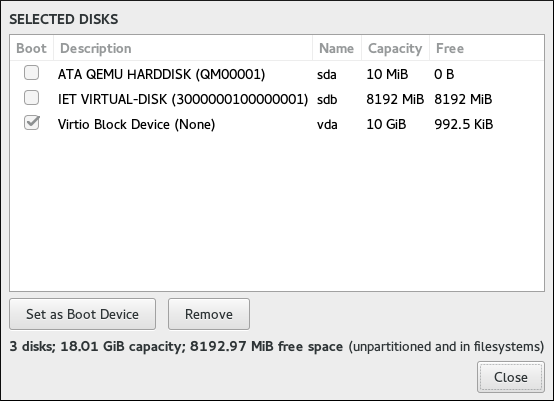
In the Boot column, a "tick" icon marks one of the devices as the intended boot device. To change the boot device, select a device from the list and click the Set as Boot Device button to install the boot loader there instead. Only one device can be set as the boot device.
To decline installation of a new boot loader, select the device currently marked for boot and click the Do not install bootloader button. This will remove the tick and ensure GRUB2 is not installed on any device.
|
If you choose not to install a boot loader for any reason, you will not be able to boot the system directly, and you must use another boot method, such as a stand-alone commercial boot loader application. Use this option only if you are sure you have another way to boot your system. |
The boot loader may also require a special partition to be created, depending on whether your system uses BIOS or UEFI firmware and also depending on whether the boot drive has a GUID Partition Table (GPT) or a Master Boot Record (MBR, also known as msdos) label. If you use automatic partitioning, the installer will create this partition if needed. For details, see Recommended Partitioning Scheme.
Installation Destination - Specialized & Network Disks
This part of the Installation Destination screen allows you to configure non-local storage devices, namely iSCSI and FCoE storage. This section will mostly be useful to advanced users who have a need for networked disks. For instructions on setting up local hard drives, see Installation Destination.
|
This section only explains how to make existing network disks available inside the installer. It does not explain how to set up your network or a storage server, only how to connect to them. |
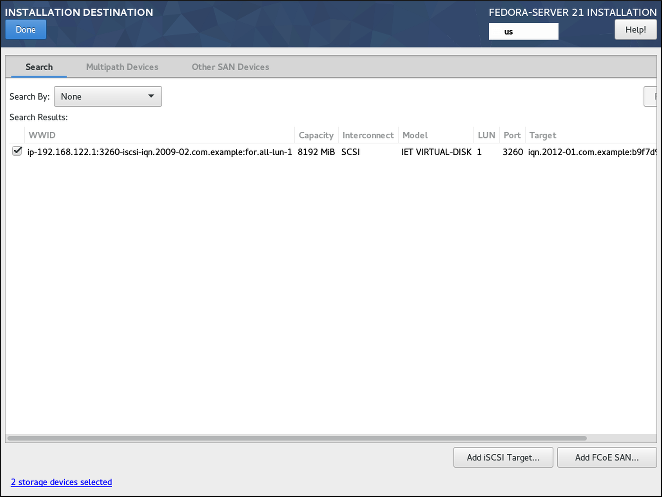
The screen contains a list of all currently available (discovered) network storage devices. When the screen is opened for the first time, the list will be empty in most cases because no network storage has been discovered - the installer makes no attempt at discovering this unless you configure network disks using a Kickstart file.
To add one or more storage devices to the screen so you can search them and use them in the installation, click Add iSCSI Target or Add FCoE SAN in the bottom right corner of the screen, and follow the instructions in Add iSCSI Target or Add FCoE SAN, depending on which type of network storage you want to add.
Network storage devices successfully discovered and configured by the installer will then be displayed in the main list, along with identifying information such as Name, WWID, Model and Target. To sort the list by a specific column (for example WWID), click the column’s heading.
|
On lower display resolutions, the list may be too wide to fit on the screen, and some of the columns or buttons may be hidden initially. Use the horizontal scroll bar at the bottom of the list to move your view and see all available table columns and controls. |
There are three tabs on the top of the list, which display different information:
- Search
-
Displays all available devices, regardless of their type, and allows you to filter them either by their World Wide Identifier (WWID) or by the port, target, or logical unit number (LUN) at which they are accessed.
- Multipath Devices
-
Storage devices accessible through more than one path, such as through multiple SCSI controllers or Fiber Channel ports on the same system.
The installation program only detects multipath storage devices with serial numbers that are 16 or 32 characters long.
- Other SAN Devices
-
Devices available on a Storage Area Network (SAN).
Depending on the tab you are currently in, you can filter the discovered devices by using the Filter By field. Some of the filtering options are automatically populated based on discovered devices (for example, if you select Filter By: Vendor, another drop-down menu will appear showing all vendors of all discovered devices). Other filters require your input (for example when filtering by WWID), and present you with a text input field instead of a drop-down menu.
In the list (regardless of how it is filtered), each device is presented on a separate row, with a check box to its left. Mark the check box to make the device available during the installation process; this will cause this device (node) to be shown in the Specialized & Network Disks section in Installation Destination. There, you can select the disk as an installation target and proceed with either manual or automatic partitioning.
|
Devices that you select here are not automatically wiped by the installation process. Selecting a device on this screen does not, in itself, place data stored on the device at risk. Also note that any devices that you do not select here to form part of the installed system can be added to the system after installation by modifying the |
When you have selected the storage devices to make available during installation, click Done to return to Installation Destination.
iSCSI Hedefi Ekle
iSCSI depolama aygıtlarını kullanmak için, kurucunun bunları iSCSI hedefleri olarak keşfedebilmesi ve bunlara erişmek için bir iSCSI oturumu oluşturabilmesi gerekir. Bu adımların her ikisi de Zorlu El Sıkışma Kimlik Doğrulama Protokolü (Challenge Handshake Authentication Protocol - CHAP) kimlik doğrulaması için bir kullanıcı adı ve parola gerektirebilir.
Bir iSCSI hedefini, hem keşif hem de oturum için hedefin bağlı olduğu sistemdeki iSCSI başlatıcının kimliğini doğrulamak için (ters CHAP) yapılandırabilirsiniz. Birlikte kullanıldığında CHAP ve ters CHAP, karşılıklı CHAP veya iki yönlü CHAP olarak adlandırılır. Karşılıklı CHAP, özellikle CHAP kimlik doğrulaması ve ters CHAP kimlik doğrulaması için kullanıcı adı ve parolası farklıysa, iSCSI bağlantıları için en yüksek güvenlik düzeyini sağlar.
Sisteminize bir iSCSI depolama hedefi eklemek için aşağıdaki adımları izleyin.
-
Kurulum Hedefi - Özelleşmiş Diskler ve Ağ Diskleri ekranının sağ alt köşesindeki
iSCSI Hedefi Ekledüğmesine tıklayın.iSCSI Depolama Hedefi Eklebaşlıklı yeni bir iletişim penceresi açılacaktır. -
iSCSI hedefinin IP adresini
Hedef IP Adresialanına girin. -
iSCSI başlatıcı için
iSCSI Başlatıcı Adıalanına iSCSI Nitelikli Adı (iSCSI Qualified Name - IQN) biçiminde bir ad girin. Geçerli bir IQN girdisi şunları içerir:-
iqn.dizgesi (nokta dahil). -
Organizasyonunuzun internet etki alanı veya alt etki alanı adının kaydedildiği yılı ve ayı belirten, yıl için dört basamak, bir kısa çizgi ve ay için iki basamak ve ardından bir nokta olarak temsil edilen bir tarih kodu. Örneğin, Eylül 2010’u
2010-09.olarak temsil edin. -
Ters sırayla (üst düzey etki alanı önce) olacak şekilde organizasyonunuzun internet etki alanı veya alt etki alanı adı. Örneğin, storage.example.com alt etki alanını
com.example.storageolarak temsil edin. -
İki nokta üst üste (
:), ardından etki alanınızda veya alt etki alanınızda bu belirli iSCSI başlatıcıyı benzersiz şekilde tanımlayan bir dizge. Örneğin,:diskarrays-sn-a8675309Yani tam bir IQN aşağıdaki gibi görünecektir:
iqn.2010-09.com.example.storage:diskarrays-sn-a8675309Doğru biçimi kullanan bir örnek, yol göstermesi için ayrıca giriş alanının altında görüntülenir.
IQN’ler hakkında daha fazla bilgi için https://tools.ietf.org/html/rfc3720#section-3.2.6 adresinde bulunan 3.2.6. iSCSI Names in RFC 3720 - Internet Small Computer Systems Interface (iSCSI) ve https://tools.ietf.org/html/rfc3721#section-1 adresinde bulunan 1. iSCSI Names and Addresses in RFC 3721 - Internet Small Computer Systems Interface (iSCSI) Naming and Discovery sayfalarına bakın.
-
-
Keşif Kimlik Doğrulama Türüaçılır menüsünü kullanarak iSCSI keşfi için kullanılacak kimlik doğrulama türünü belirtin. Hangi kimlik doğrulama türünü seçtiğinize bağlı olarak, ek giriş alanları (CHAP Kullanıcı adıveCHAP Parolasıgibi) daha sonra görünür hale gelebilir. Kimlik doğrulama bilgilerinizi doldurun; bunlar organizasyonunuz tarafından sağlanmalıdır. -
Keşfi Başlatdüğmesine tıklayın. Kurucu, sağladığınız bilgilere göre bir iSCSI hedefi keşfetmeye çalışacak ve hedef CHAP veya ters CHAP kimlik doğrulaması gerektiriyorsa, sağladığınız kimlik bilgilerini kullanmaya çalışacaktır. Bu işlem, ağınıza bağlı olarak biraz zaman (genellikle 30 saniyeden az) alabilir.Keşif başarılı olmazsa, iletişim penceresinde bir hata mesajı görüntülenecektir. Bu mesaj, keşfin hangi kısmının başarısız olduğuna bağlı olarak değişecektir. Kurucu belirttiğiniz hedefi hiç bulamadıysa, IP adresini gözden geçirmelisiniz; sorun bir kimlik doğrulama hatasıysa, tüm CHAP ve ters CHAP kimlik bilgilerini doğru girdiğinizden ve iSCSI hedefine erişiminiz olduğundan emin olun.
Düğüm bulunamadıhata mesajı, belirttiğiniz adresteki tüm düğümlerin zaten yapılandırılmış olduğu anlamına da gelebilir. Keşif sırasında, Anaconda zaten eklenmiş olan düğümleri yok sayar.Keşif başarılı olduysa, keşfedilen tüm düğümlerin bir listesini göreceksiniz.
-
Hedefte keşfedilen her düğümün yanındaki onay kutusunu işaretleyerek veya işaretini kaldırarak oturum açmak istediğiniz bir veya daha fazla düğümü seçin. Listenin altında, kullanmak istediğiniz kimlik doğrulama türünü yeniden seçin; hedefi keşfetmek için kullandığınız CHAP/ters CHAP kullanıcı adı ve parolası hedefe giriş yapmak için de geçerliyse,
Keşifteki kimlik bilgilerini kullanseçeneğini de seçebilirsiniz.Kullanmak istediğiniz tüm düğümleri seçtikten sonra, bir iSCSI oturumu başlatmak için
Giriş Yapdüğmesine tıklayın. Anaconda, seçilen tüm düğümlere giriş yapmaya çalışacaktır. Giriş yapma işlemi başarılı olursa,iSCSI Depolama Hedefi Ekleiletişim kutusu kapanacak ve yapılandırdığınız tüm düğümler artık Kurulum Hedefi - Özelleşmiş Diskler ve Ağ Diskleri bölümündeki ağ diskleri listesinde gösterilecektir.
Ek iSCSI hedefleri keşfetmek veya önceden yapılandırılan bir hedeften daha fazla düğüm eklemek için bu adımları tekrarlayabilirsiniz. Ancak, Keşfi Başlat düğmesine ilk kez tıkladığınızda, iSCSI Başlatıcı Adı alanını değiştiremeyeceğinizi unutmayın. Başlatıcı adını yapılandırırken bir hata yaptıysanız, kurulumu yeniden başlatmanız gerekir.
Add FCoE SAN
The following procedure explains how to add Fibre Channel over Ethernet (FCoE) storage devices and make them available during the installation:
-
Click the
Add FCoE SANbutton in the bottom right corner of Installation Destination - Specialized & Network Disks. A new dialog window will open. -
Select the network interface (
NIC) which is connected to your FCoE switch from the drop-down menu. Note that this network interface must be configured and connected - see Network & Hostname. -
Below the
NICdrop-down menu are two choices:Use DCB-
Data Center Bridging (DCB) is a set of enhancements to the Ethernet protocols designed to increase the efficiency of Ethernet connections in storage networks and clusters. This option should only be enabled for network interfaces that require a host-based DCBX client. Configurations on interfaces that implement a hardware DCBX client should leave this check box empty.
Use auto vlan-
This option indicates whether VLAN discovery should be performed. If this box is checked, then the FCoE Initiation Protocol (FIP) VLAN discovery protocol will run on the Ethernet interface once the link configuration has been validated. If they are not already configured, network interfaces for any discovered FCoE VLANs will be automatically created and FCoE instances will be created on the VLAN interfaces. This option is enabled by default.
-
After you select which interface and options to use, click
Add FCoE Disk(s). Discovered FCoE storage devices will be displayed under theOther SAN Devicestab in Installation Destination - Specialized & Network Disks.
Elle Bölümlendirme
Elle Bölümlendirme ekranı, Fedora sisteminiz için elle bir depolama yapılandırması oluşturmanıza olanak tanır ve sisteminizin depolama alanı üzerinde size daha fazla denetim imkanı verir.
Hem Linux hem de diğer işletim sistemleri için diğer kurucuların çoğunda, disk bölümlendirme genellikle "aşağıdan yukarıya" bir yaklaşım benimser. Bu kurucularda, önce LVM fiziksel birimleri gibi altta yatan aygıtları oluşturursunuz, ardından bunların üzerine LVM gibi bir düzen oluşturursunuz, ardından mantıksal birimlerin üzerinde dosya sistemleri oluşturursunuz ve son adım genellikle her birim için bir bağlama noktası atamaktır.
Anaconda tam tersi bir yaklaşım kullanır. İlk olarak, ihtiyacınız olan tüm ayrı bağlama noktalarını oluşturursunuz ve bunları oluşturmak için gereken her şey (bir birim grubu, onun içindeki mantıksal birimler ve birim grubunun yer alacağı fiziksel birimlerin oluşturulması) otomatik olarak gerçekleştirilir. Daha sonra otomatik ayarları istediğiniz gibi düzenleyebilirsiniz.
|
Gerçek bölümlendirme işlemi sırasında disklerinizde kalıcı değişiklikler yapılmayacaktır. Seçtiğiniz yapılandırma, yalnızca Kurulum Özeti ekranındaki |
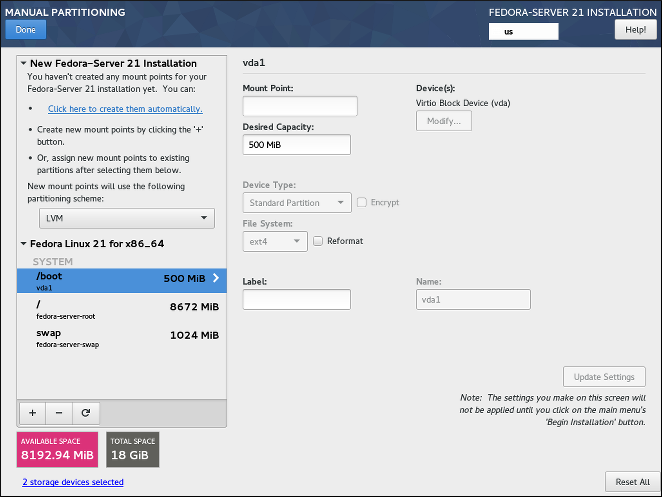
Elle Bölümlendirme ekranını ilk açtığınızda sol taraftaki sütun, Kurulum Hedefi bölümünde kurulum hedefleri olarak seçtiğiniz tüm disklerde önceden var olan tüm bölümleri görüntüleyecektir. Seçilen disklerin hiçbiri bir bölüm içermiyorsa, size şu anda hiçbir bağlama noktasının olmadığını bildiren bir mesaj görünecektir.
Burada, LVM veya BTRFS gibi bir bölümlendirme şeması seçebilir ve kurucudan basit bir bölümlendirme düzeni oluşturmasını istemek için Otomatik olarak oluşturmak için buraya tıklayın seçeneğine tıklayabilirsiniz; bu düzen Tavsiye Edilen Bölümlendirme Düzeni bölümünde açıklanan yönergeleri izler. Oluşturulan düzen, bölüm/birim boyutlarının toplam kullanılabilir alan miktarına göre otomatik olarak belirlendiği basit bir düzendir.
Bir bağlama noktası eklemek için + düğmesine tıklayın. Açılan iletişim penceresinde, / veya /home gibi bir bağlama noktası ve bağlama noktası için istenen kapasiteyi (10GB veya 500MB gibi) seçin. Bağlama noktasını belirtmenin zorunlu olduğunu, ancak bu noktada kapasiteyi belirtmenin gerekli olmadığını unutmayın; bu, o anda kullanılabilir alanın izin verdiğinden daha büyük olmasını istediğiniz bir bağlama noktası eklerken faydalıdır. Ardından, öntanımlı ayarları kullanarak (yani mantıksal birim olarak oluşturulacak ve zaten mevcut değilse yeni bir birim grubu oluşturulacaktır) listeye eklemek için Bağlama noktası ekle düğmesine tıklayın.
Ardından, sol taraftaki listeden yeni oluşturulan bağlama noktasını seçin. Ekranın sağ tarafında bağlama noktasını, fiziksel olarak bulunacağı aygıtı, kapasitesini, dosya sistemini vb. değiştirmenize olanak tanıyan bir dizi denetim görüntülenecektir. Herhangi bir ayarı değiştirdiğinizde, Ayarları Güncelle düğmesine basın. sağ altta. Bu, değiştirilen yapılandırmayı kaydedecektir; ardından başka bir bağlama noktası oluşturabilir veya mevcut farklı bir noktayı seçip ayarlarını düzenleyebilirsiniz.
|
Kullanılabilir aygıt ve dosya sistemi türlerinin açıklaması için Aygıt, Dosya Sistemi ve RAID Türleri bölümüne bakın. |
Bir bağlama noktasını kaldırmak için listeden seçin ve aşağıdaki - düğmesine basın.
Depolamanızı yapılandırmanın tam adımları, özel ihtiyaçlarınıza ve sistem yapılandırmanıza bağlıdır. Özel düzenler oluşturma adımları bu bölümün ilerisinde daha ayrıntılı olarak açıklanmaktadır. Başlamadan önce, disklerinizi Fedora için bölümlendirmeye yönelik gereksinimler ve ipuçlarının bir listesi için Tavsiye Edilen Bölümlendirme Düzeni ve Bölümlerle İlgili Tavsiyeler bölümlerini de incelemelisiniz.
Mevcut bağlama noktaları listesinin altında, depolama aygıtlarınızda ne kadar boş alan kaldığını ve toplam ne kadar alana sahip olduklarını gösteren iki alan vardır.
Seçili olan depolama aygıtlarının bir özetini görüntülemek için X depolama aygıtı seçildi seçeneğine tıklayın; bu, daha karmaşık depolama düzenlerinde yönlendirme konusunda size yardımcı olabilir. Burada görüntülenen aygıtlar, Kurulum Hedefi bölümünde seçmiş olduğunuz aygıtlardır. Yapılandırmanıza herhangi bir depolama aygıtı eklemek veya çıkarmak isterseniz, o ekrana dönün ve seçiminizi değiştirin.
Depolama yapılandırmasını Elle Bölümlendirme ekranını en son açtığınız zamanki durumuna sıfırlamak için istediğiniz zaman sağ alt köşedeki Tümünü Sıfırla düğmesine basabilirsiniz. Bu, depolama yapılandırmasını değiştirirseniz, ekrandan ayrılırsanız ve ardından geri gelirseniz, Sıfırla düğmesinin yapılandırmayı zaten değiştirilmiş olan durumuna sıfırlayacağı ve yalnızca son zamanlarda yaptığınız değişiklikleri atacağı, kurucuyu önyükledikten sonra depolama yapılandırmasında yapılan tüm değişiklikleri atmayacağı anlamına gelir.
Tüm değişiklikleri iptal etmek ve ayrıca kurucu başladığında algılanmayan yeni diskleri tespit etmek için (bu, genellikle başlattıktan sonra yeni bir disk taktığınızda olur), ekranın sol tarafında bağlama noktaları listesinin altındaki denetimler kümesinde dairesel bir okla işaretlenen düğmeye basın. Açılan iletişim penceresinde Diskleri Yeniden Tara düğmesine basın ve tarama işlemi tamamlanana kadar bekleyin. Ardından, Kurulum Hedefi bölümüne dönmek için Tamam düğmesine basın; yenileri de dahil olmak üzere algılanan tüm diskler Yerel Standart Diskler bölümünde görüntülenecektir.
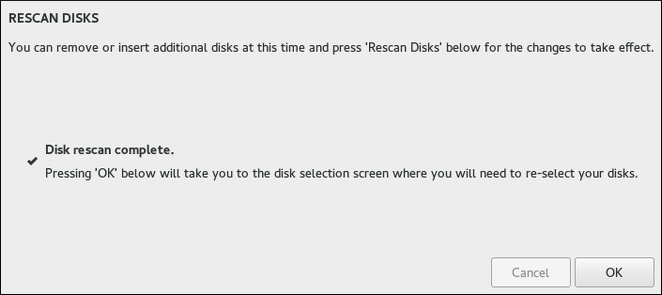
Sistem depolama alanınızı yapılandırmayı bitirdikten sonra, yapılandırmayı kaydetmek ve Kurulum Özeti ekranına dönmek için sol üst köşedeki Bitti düğmesine basın. Bu noktada kurucu, depolama yapılandırmanızın geçerli olup olmadığını denetleyecektir. Bir hata tespit edilirse, ekranın altında bir mesaj görüntülenecektir. Ne tür bir hatanın tespit edildiğini açıklayan bir iletişim penceresi açmak için mesaja tıklayın (örneğin, / boot dizinini bir Btrfs alt birimine koydunuz veya sisteminiz gerektirdiği halde bir BIOS Önyükleme bölümü oluşturmadınız).
Böyle bir mesaj görüntülenirse, geri dönün ve kurucu tarafından bulunan sorunları düzeltin; aksi takdirde kuruluma devam edemezsiniz. Yine de Kurulum Özeti ekranına dönmek için tekrar Bitti düğmesine basabilirsiniz, ancak depolama yapılandırma hatası gerçek kurulum sürecini başlatmanızı engelleyecektir.
Herhangi bir hata mesajı görüntülenmezse ve bu ekranı son ziyaretinizden bu yana herhangi bir değişiklik yaptıysanız, yaptığınız değişikliklerin ayrıntılı bir listesini görüntüleyen bir özet iletişim kutusu görünecektir. Listeyi gözden geçirin ve Kurulum Özeti ekranına ilerlemek için Değişiklikleri Kabul Et, daha fazla değişiklik yapmak istiyorsanız İptal Et ve Özel Bölümlendirmeye Dön düğmesine tıklayın.
Creating Standard Partitions
Standard partitions are the most common type of partition, with the widest support across operating systems. For example, Microsoft Windows uses exclusively physical partitions and can not natively work with LVM or Btrfs. Most Fedora partitioning setups will also require at least one standard partition for the /boot directory, and possibly also another standard partition with the BIOS Boot or EFI System file system to store the boot loader.
See An Introduction to Disk Partitions for additional information about the concepts behind physical partitions.
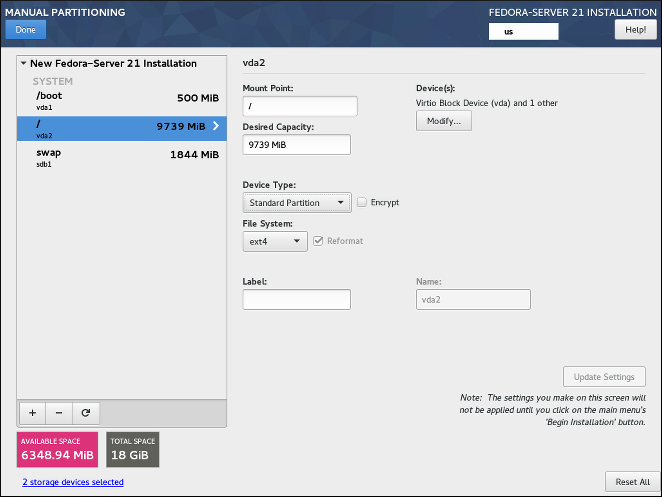
Follow the procedure below to create mount points on standard physical partitions:
-
Click the
+button at the bottom of the list showing existing mount points. A new dialog window will open. -
In the new dialog window, specify a mount point for which you want to create a separate mount point - for example,
/. Optionally, specify a size for the partition using standard units such as MB or GB (for example,50GB). Then, clickAdd mount pointto add the mount point and return to the main partitioning screen.When creating a swap partition, specify the mount point as
swap. For a BIOS Boot partition, usebiosboot. For an EFI System Partition, use/boot/efi.For information about these partition types, see Recommended Partitioning Scheme.
-
The mount point has now been created using the default settings, which means it has been created as an LVM logical volume. Select the newly created mount point in the left pane to configure it further, and convert it to a physical partition by changing the
Device Typeoption toStandard Partition. Then, clickUpdate Settingsin the bottom right corner of the screen. -
In the
Device(s)section on the right side of the screen, you can see that the partition has been assigned to one or more hard drives. Click theModifybutton to configure on which drive this partition will be created. -
In the
Configure Mount Pointdialog, you can specify which physical devices (disks) this volume may reside on. You can select one or more disks which will be used to hold this volume by holding down Ctrl and clicking each disk in the list. If you select multiple disks here, Anaconda will determine where exactly the partition should be created based on how you configured the rest of the installation. If you want to make sure that this partition is placed on a specific hard drive, select only that drive and unselect all others.After you finish configuring the partition’s location, click
Saveto return to the mainManual Partitioningscreen. -
Configure other settings specific to the partition - its
Mount Point,Desired Capacity, andFile System. PressUpdate Settingsto apply any changes to the configuration.
Repeat this procedure for any additional standard partitions you want to create.
Yazılımsal RAID Oluşturma
Bağımsız disklerin yedekli dizileri (Redundant arrays of independent disks - RAID), artırılmış performans ve bazı yapılandırmalarda hatalara karşı daha fazla dayanıklılık sağlayacak şekilde düzenlenen birden çok depolama aygıtından oluşturulur. Farklı RAID türlerinin açıklamaları için Aygıt, Dosya Sistemi ve RAID Türleri bölümüne bakın.
Bir RAID aygıtı tek bir adımda oluşturulur ve gerektiğinde diskler eklenir veya çıkarılır. Her aygıt için fiziksel disk başına bir RAID bölümüne izin verilir, bu nedenle kurulum programında bulunan kullanılabilir disk sayısı, sizin için hangi RAID aygıt düzeylerinin kullanılabilir olduğunu belirler. Örneğin, sisteminizde iki sabit disk varsa, kurulum programı 4 ayrı bölüm gerektiren bir RAID10 aygıtı oluşturmanıza izin vermeyecektir.
|
Bu bölümde yalnızca standart (fiziksel) bölümlerle nasıl yazılımsal RAID oluşturulacağı açıklanmaktadır. Ancak, LVM birim gruplarını ve Btrfs birimlerini RAID kullanacak şekilde yapılandırabilir ve onların mantıksal birimlerini veya Btrfs alt birimlerini bu RAID dizisinin üstüne yerleştirebilirsiniz. LVM ve Btrfs’de RAID oluşturma talimatları için Mantıksal Birim Yönetimi (Logical Volume Management - LVM) Düzeni Oluşturma ve Btrfs Düzeni Oluşturma bölümlerine bakın. |
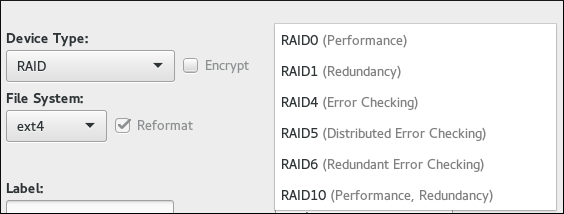
|
RAID yapılandırma seçenekleri yalnızca kurulum için iki veya daha fazla disk seçtiyseniz görünür. Bir RAID aygıtı oluşturmak için en az iki disk gereklidir ve bazı RAID düzenleri daha fazlasını gerektirir. Farklı RAID türleri için gereksinimler Aygıt, Dosya Sistemi ve RAID Türleri bölümünde açıklanmaktadır. |
Yazılımsal RAID oluşturmak için aşağıdaki adımları izleyin:
-
Mevcut bağlama noktalarını gösteren listenin altındaki
+düğmesine tıklayın. Yeni bir iletişim penceresi açılacaktır. -
Yeni iletişim penceresinde, ayrı bir yazılımsal RAID bölümü oluşturmak istediğiniz bir bağlama noktası belirtin - örneğin,
/. İsteğe bağlı olarak, MB veya GB gibi standart birimler (örneğin,50GB) kullanarak yeni bölüm için bir boyut belirtin. Ardından, bağlama noktasını eklemek ve ana bölümlendirme ekranına geri dönmek içinBağlama noktası ekledüğmesine tıklayın.Yazılımsal RAID üzerinde takas için bir bağlama noktası oluştururken, bağlama noktasını
swapolarak belirtin. -
Bu adımdan sonra bağlama noktası öntanımlı ayarlar kullanılarak, yani bir LVM mantıksal birimi olarak oluşturulur. Daha fazla yapılandırmak için sol bölmede yeni oluşturulan bağlama noktasını seçin ve
Aygıt TürüseçeneğiniRAIDolarak değiştirerek bir yazılımsal RAID bölümüne dönüştürün. -
RAID Seviyesiaçılır menüsünden bir RAID türü seçin. Kullanılabilir RAID türleri ve gereksinimleri Aygıt, Dosya Sistemi ve RAID Türleri bölümünde açıklanmaktadır. -
Ekranın sağ tarafındaki
Aygıt(lar)bölümünde, bölümün birkaç fiziksel diske atandığını görebilirsiniz. Bu bölümün hangi diskler üzerinde oluşturulacağını yapılandırmak içinDeğiştirdüğmesine tıklayın. -
Bağlama Noktası Yapılandıriletişim kutusunda, bu birimin hangi fiziksel aygıtlarda (diskler) bulunabileceğini belirleyebilirsiniz. Bu bölümü tutmak için kullanılacak bir veya daha fazla diski Ctrl tuşuna basılı tutup listedeki her diski tıklayarak seçebilirsiniz. Bu bölümün belirli bir sabit disk kümesinde oluşturulduğundan emin olmak istiyorsanız, yalnızca o diskleri seçin ve diğerlerinin seçimini kaldırın.Bölümün konumunu yapılandırmayı bitirdikten sonra, ana
Elle Bölümlendirmeekranına dönmek içinKaydetdüğmesine tıklayın. -
Bölüme özgü diğer ayarları yapılandırın -
Bağlama Noktası,İstenen KapasiteveDosya Sistemi. Değişiklikleri yapılandırmaya uygulamak içinAyarları Güncelledüğmesine basın.
Oluşturmak istediğiniz ek yazılımsal RAID ile standart bölümler için bu adımları tekrarlayın.
Creating a Logical Volume Managament (LVM) Layout
Logical Volume Management (LVM) presents a simple logical view of underlying physical storage space, such as hard drives or LUNs. Partitions on physical storage are represented as physical volumes that can be grouped together into volume groups. Each volume group can be divided into multiple logical volumes, each of which is analogous to a standard disk partition. Therefore, LVM logical volumes function as partitions which can span multiple physical disks.
See Understanding LVM for additional information about the concepts behind Logical Volume Management.
|
Some partition types - notably the |
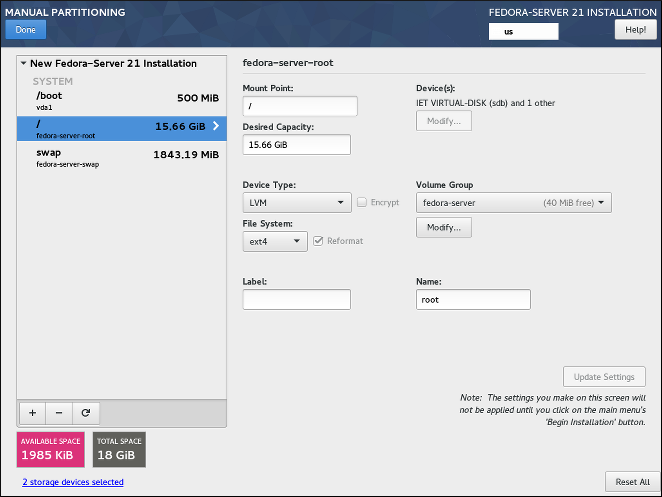
Follow the procedure below to create LVM logical volumes and volume groups.
-
Click the
+button at the bottom of the list showing existing mount points. A new dialog window will open. -
In the new dialog window, specify a mount point for which you want to create a separate logical volume - for example,
/. Optionally, specify a size for the volume using standard units such as MB or GB (for example,50GB). Then, clickAdd mount pointto add the volume and return to the main partitioning screen.When creating a mount point for swap on LVM, specify the mount point as
swap. -
The mount point has now been created using the default settings, which means it has been created as an LVM logical volume, and a volume group has been created to contain it. Select the newly created mount point in the left pane to configure it further. If you want to use thin provisioning for this volume, change the
Device Typeoption toLVM Thin Provisioning. -
In the
Volume Groupmenu, you can see that the volume has been assigned to an automatically created volume group, which is named after the Fedora variant you are installing (for example,fedora-server. Click theModifybutton under the drop-down menu to access the volume group settings. -
In the
Configure Volume Groupdialog, you can change the volume group’s name, itsRAID level(see Device, File System and RAID Types for information about available RAID types), and you can also specify which physical devices (disks) this volume group should reside on. You can select one or more disks which will be used to hold this volume group by holding down Ctrl and clicking each disk in the list.If you select a redundant RAID type (such as
RAID1 (Redundancy)), the volume group will take up twice its actual size on your disks. A 5 GB volume group with RAID1 will take up 10 GB of space.You can also make sure that the volume group is encrypted by selecting the
Encryptoption; this will enable LUKS encryption for the entire volume group. See the Fedora Security Guide, available at https://docs.fedoraproject.org/, for information about LUKS disk encryption.Additionally, you can set a fixed size for the volume group by selecting the
Fixedoption from theSize policymenu and entering a size for the volume group.After you finish configuring the volume group settings, click
Saveto return to the mainManual Partitioningscreen.The configuration dialog does not allow you to specify the size of the volume group’s physical extents. The size will always be set to the default value of 4 MiB. If you want to create a volume group with different physical extents, create it manually by switching to an interactive shell and using the vgcreate command, or use a Kickstart file with the volgroup --pesize=size command.
-
If you need to create more than one volume group, open the
Volume Groupdrop-down menu and select theCreate a new volume groupoption. A new dialog window will open, identical to the one described in the previous step. Again, select a name, storage devices, encryption settings, RAID level and size policy for the new group, and clickSave. The new volume group will then become available in theVolume Groupdrop-down menu; you can then go through your existing mount points and change this setting to assign them to a different volume group. -
Configure other settings specific to the logical volume - its
Mount Point,Desired Capacity,File System, andName. PressUpdate Settingsto apply any changes to the configuration.
Repeat this procedure for any additional logical volumes you want to create. Note that when creating additional LVM logical volumes, a new volume group is not automatically created each time; instead, any additional volumes are assigned to an existing group.
For each mount point you create, review its settings and make sure that it is assigned to the correct group, that it has sufficient capacity, and that it has a descriptive name so you can identify the volume later if you need to.
Creating a Btrfs Layout
Btrfs is a type of file system, but it has several features characteristic of a storage device. It is designed to make the file system tolerant of errors, and to facilitate the detection and repair of errors when they occur. It uses checksums to ensure the validity of data and metadata, and maintains snapshots of the file system that can be used for backup or repair.
Creating a Btrfs layout is somewhat similar to LVM (described in Creating a Logical Volume Managament (LVM) Layout) with slightly different terminology. A Btrfs volume is the equivalent of an LVM volume group, and a Btrfs subvolume is similar to a LVM logical volume. An important difference to note is how Anaconda reports sizes for separate mount points: For LVM, the exact size of each logical volume is shown next to each mount point in the left pane, while with Btrfs, the total size of the entire volume is shown next to each subvolume.
|
Some partition types - notably the |
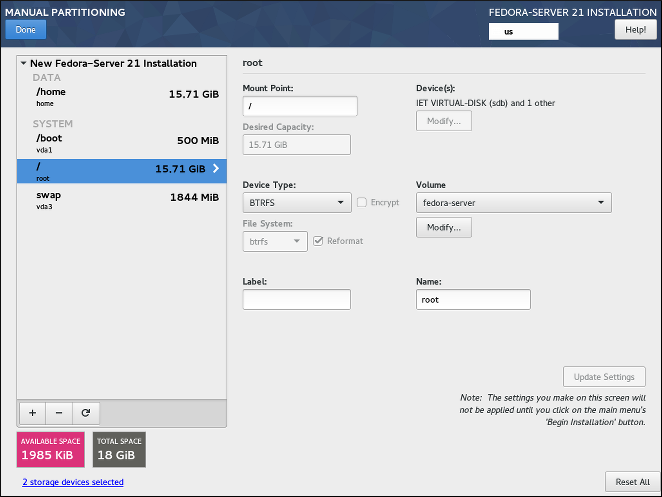
Follow the procedure below to create Btrfs volumes and subvolumes:
-
Click the
+button at the bottom of the list showing existing mount points. A new dialog window will open. -
In the new dialog window, specify a mount point for which you want to create a separate logical volume - for example,
/. Optionally, specify a size for the volume using standard units such as MB or GB (for example,50GB). Then, clickAdd mount pointto add the volume and return to the main partitioning screen.When creating a mount point for swap on Btrfs, specify the mount point as
swap. -
The mount point has now been created using the default settings, which means it has been created as an LVM logical volume. Select the newly created mount point in the left pane to configure it further, and convert it to a Btrfs subvolume by changing the
Device Typeoption toBtrfs. Then, clickUpdate Settingsin the bottom right corner of the screen. -
In the
Volumemenu, you can see that the subvolume has been assigned to an automatically created volume, which is named after the Fedora variant you are installing (for example,fedora-server00. Click theModifybutton under the drop-down menu to access the volume settings. -
In the
Configure Volumedialog, you can change the volume’s name, itsRAID level(see Device, File System and RAID Types for information about available RAID types), and you can also specify which physical devices (disks) this volume should reside on. You can select one or more disks which will be used to hold this volume by holding down Ctrl and clicking each disk in the list.If you select a redundant RAID type (such as
RAID1 (Redundancy)), the volume will take up twice its actual size on your disks. A 5 GB volume with RAID1 will take up 10 GB of space.You can also make sure that the volume is encrypted by selecting the
Encryptoption; this will enable LUKS encryption for the entire volume. See the Fedora Security Guide, available at https://docs.fedoraproject.org/, for information about LUKS disk encryption.Additionally, you can set a fixed size for the volume by selecting the
Fixedoption from theSize policymenu and entering a size for the volume group.After you finish configuring the Btrfs volume settings, click
Saveto return to the mainManual Partitioningscreen. -
If you need to create more than one Btrfs volume, open the
Volumedrop-down menu and select theCreate a new volume groupoption. A new dialog window will open, identical to the one described in the previous step. Again, select a name, storage devices, encryption settings, RAID level and size policy for the new volume, and clickSave. The new volume will then become available in theVolume Groupdrop-down menu; you can then go through your existing mount points and change this setting to assign them to a different volume. -
Configure other settings specific to the subvolume - its
Mount Point,Desired Capacity,File System, andName. PressUpdate Settingsto apply any changes to the configuration.
Repeat this procedure for any additional Btrfs subvolumes you want to create. Note that when creating additional subvolumes, a new volume is not automatically created each time; instead, any additional subvolumes are assigned to an existing volume.
For each mount point you create, review its settings and make sure that it is assigned to the correct volume, that it has sufficient capacity, and that it has a descriptive name so you can identify the subvolume later if you need to.
Device, File System and RAID Types
Fedora supports multiple types of devices and file systems. The lists below offer a short description of each available device, file system and RAID type and notes on their usage.
To select a device type or a file system of a partition or a logical volume, select it in the list in Manual Partitioning and select a Device Type and a File System from their respective drop-down menus on the right side of the screen. Then, click Update Settings and repeat this process for all mount points you want to modify.
To configure software RAID, make sure that you have enough physical hard drives selected as installation targets (the number of separate drives required for each type of RAID is noted in its description). Then, choose a RAID level when creating or modifying a Btrfs volume or LVM volume group, or select Software RAID as the device type to create software RAID with standard partitions. For detailed instructions, see Creating a Btrfs Layout, Creating a Logical Volume Managament (LVM) Layout, and Creating Software RAID as needed.
-
Standard Partition- A standard partition can contain a file system or swap space. Standard partitions are most commonly used for/bootand the BIOS Boot and EFI System partitions. LVM logical volumes or Btrfs subvolumes are recommended for most other uses. See An Introduction to Disk Partitions for additional information about the concepts behind physical partitions. -
LVM- ChoosingLVMas theDevice Typecreates an LVM logical volume and a volume group to contain it (unless one already exists, in which case the new volume is assigned to the existing group). LVM can improve performance when using physical disks and allows you to use multiple disks for a single mount point. For information on how to create a logical volume, see Creating a Logical Volume Managament (LVM) Layout. Also see Understanding LVM for some additional information about LVM in general. -
LVM Thin Provisioning- Using thin provisioning, you can manage a storage pool of free space, known as a thin pool, which can be allocated to an arbitrary number of devices when needed by applications. The thin pool can be expanded dynamically when needed for cost-effective allocation of storage space. -
RAID- Creating two or more software RAID partitions allows you to create a software RAID device. One RAID partition is assigned to each disk on the system. See Creating Software RAID for instructions on creating software RAID. -
BTRFS- Btrfs is a file system with several device-like features. It is capable of addressing and managing more files, larger files, and larger volumes than the ext2, ext3, and ext4 file systems. See Creating a Btrfs Layout for more information about creating Btrfs volumes.
-
ext4- The ext4 file system is based on the ext3 file system and features a number of improvements. These include support for larger file systems and larger files, faster and more efficient allocation of disk space, no limit on the number of subdirectories within a directory, faster file system checking, and more robust journaling. Ext4 is the default and recommended file system used by Fedora Workstation and Cloud. The maximum supported size of a single ext4 file system is 50 TB. -
ext3- The ext3 file system is based on the ext2 file system and has one main advantage - journaling. Using a journaling file system reduces time spent recovering a file system after a crash, as there is no need to check the file system for metadata consistency by running the fsck utility every time a crash occurs. -
ext2- An ext2 file system supports standard Unix file types, including regular files, directories, or symbolic links. It provides the ability to assign long file names, up to 255 characters. -
swap- Swap partitions are used to support virtual memory. In other words, data is written to a swap partition when there is not enough RAM to store the data your system is processing. A swap partition should always be created; see Recommended Partitioning Scheme for details such as the recommended size. -
xfs- XFS is a highly scalable, high-performance file system that supports file systems up to 16 exabytes (approximately 16 million terabytes), files up to 8 exabytes (approximately 8 million terabytes), and directory structures containing tens of millions of entries. XFS also supports metadata journaling, which facilitates quicker crash recovery. The maximum supported size of a single XFS file system is 500 TB. Starting with Fedora 22, XFS is the default and recommended file system on Fedora Server.Note that the size of an XFS file system can not currently be reduced without destroying and recreating the file system. If you expect that you will need to adjust the sizes of your file systems often, using XFS is not recommended, as it makes administration substantially more time-consuming.
-
vfat- The VFAT file system is a Linux file system that is compatible with Microsoft Windows long file names on the FAT file system. -
BIOS Boot- A very small partition required for booting from a device with a GUID partition table (GPT) on BIOS systems and UEFI systems in BIOS compatibility mode. See Recommended Partitioning Scheme for details. -
EFI System Partition- A small partition required for booting a device with a GUID partition table (GPT) on a UEFI system. See Recommended Partitioning Scheme for details.
-
RAID0 (Performance)- Distributes data across multiple disks. Level 0 RAID offers increased performance over standard partitions and can be used to pool the storage of multiple disks into one large virtual device. Note that Level 0 RAIDs offer no redundancy and that the failure of one device in the array destroys data in the entire array. RAID 0 requires at least two disks. -
RAID1 (Redundancy)- Mirrors all data from one partition onto one or more other disks. Additional devices in the array provide increasing levels of redundancy. RAID 1 requires at least two disks. -
RAID4 (Error Checking)- Distributes data across multiple disks and uses one disk in the array to store parity information which safeguards the array in case any disk within the array fails. Because all parity information is stored on one disk, access to this disk creates a "bottleneck" in the array’s performance. Level 4 RAID requires at least three disks. -
RAID5 (Distributed Error Checking)- Distributes data and parity information across multiple disks. Level 5 RAIDs therefore offer the performance advantages of distributing data across multiple disks, but do not share the performance bottleneck of level 4 RAIDs because the parity information is also distributed through the array. RAID 5 requires at least three disks. -
RAID6 (Redundant Error Checking)- Level 6 RAIDs are similar to level 5 RAIDs, but instead of storing only one set of parity data, they store two sets. RAID 6 requires at least four disks. -
RAID10 (Performance, Redundancy)- Level 10 RAIDs are nested RAIDs or hybrid RAIDs. They are constructed by distributing data over mirrored sets of disks. For example, a level 10 RAID array constructed from four RAID partitions consists of two mirrored pairs of striped partitions. RAID 10 requires at least four disks.
Tavsiye Edilen Bölümlendirme Düzeni
Çoğu durumda, en azından aşağıdaki bağlama noktaları her zaman oluşturulmalıdır:
/boot- 500 MB-
Bu bölüm, Fedora’nın önyüklenmesini sağlayan işletim sistemi çekirdeğini içerir. Ayrıca, önyükleme işlemi sırasında kullanılan diğer dosyaları da içerir. Çoğu ürün yazılımının sınırlamaları nedeniyle bu dizin için ayrı, küçük bir standart bölüm oluşturulması tavsiye edilir. Çoğu durumda, 500 MB
/bootbölümü yeterlidir.Sisteminizde bir donanımsal RAID denetleyicisi varsa, bazı BIOS türlerinin ondan önyükleme yapmayı desteklemediğini unutmayın. Bu durumda
/bootbölümü, ayrı bir sabit disk gibi RAID dizisinin dışındaki bir bölümde oluşturulmalıdır.Ayrıca
/bootdizininin bir LVM mantıksal birimine veya bir Btrfs alt birimine yerleştirilemeyeceğini unutmayın. Standart bir bölüm kullanın. /(kök) - 10 GB-
Kök dizinin bulunduğu yer burasıdır. Kök dizin, dizin yapısının en üst düzeyidir. Öntanımlı olarak, yazılan yola farklı bir bölüm bağlanmadıkça (örneğin,
/bootveya/home) tüm dosyalar bu bölüme yazılır. Bu bölümde açıklanan tavsiye edilen düzeni takip ederseniz, çoğu yazılım paketinin kurulacağı bölüm burası olacaktır.Asgari bir kurulum için 5 GB’lık bir kök bölümü yeterli olacaktır. Bununla birlikte, fazladan paketler ve bir grafiksel kullanıcı arayüzü içeren en yaygın kurulumlar için, kök bölüm en az 10 GB olmalıdır; 20 GB en yaygın kullanım durumları için yeterlidir.
/bağlama noktası, Linux Dosya Sistemi Hiyerarşisinin en üstündedir ve kök dosya sistemi veya kök olarak adlandırılır. Bazen "slash-root" olarak da telaffuz edilen/rootdizini,rootkullanıcısının ev dizinidir. /home- en az 10 GB-
Kullanıcı verilerini sistem verilerinden ayrı olarak depolamak için,
/homedizini için ayrı bir bağlama noktası oluşturun. Bu bölüm, yerel olarak depolanacak veri miktarına, kullanıcı sayısına vb. göre boyutlandırılmalıdır. Bu, kullanıcı veri dosyalarını silmeden Fedora’yı yükseltmenize veya yeniden kurmanıza olanak tanır. Kurulum sırasında, Fedora kurulumunuz için 50 GB veya daha fazla boş alan varsa ayrı bir/homebölümü oluşturulacaktır.Fedora’yı grafiksel bir ortamla normal kullanım için bir iş istasyonu olarak kullanırken, bu bağlama noktası büyük olasılıkla en fazla miktarda veriyi (kullanıcı ayarları, resimler, videolar, vb.) tutacağından, disk alanının çoğu ona atanmış olmalıdır.
- takas - sistem parametrelerinize göre
-
Takas bölümleri sanal belleği destekler; sisteminizin işlediği verileri depolamak için yeterli RAM olmadığında veriler onlara yazılır. Bu bölümün boyutu, toplam sistem belleğinin değil, sistem belleği iş yükünün bir işlevidir ve bu nedenle toplam sistem belleği boyutuna eşit değildir. Bu nedenle, sistem belleği iş yükünü belirlemek için bir sistemin hangi uygulamaları çalıştıracağını ve bu uygulamaların hizmet edeceği yükü değerlendirmek önemlidir. Uygulama sağlayıcıları ve geliştiricileri bu konuda bazı tavsiyelerde bulunabilirler.
Sistemin takas alanı tükendiğinde çekirdek, sistem RAM belleğinin tamamı kullanıldığında işlemleri sonlandırır. Çok fazla takas alanı yapılandırmak, depolama aygıtlarının tahsis edilmesine, ancak boşta olmasına ve kaynakların yetersiz kullanımına neden olur. Çok fazla takas alanı, bellek sızıntılarını da gizleyebilir. Bir takas bölümü için azami boyut ve diğer ek bilgiler
mkswap(8)kılavuz sayfasında bulunabilir.Aşağıdaki tablo, sisteminizdeki RAM miktarına ve sisteminizin hazırda bekletme için yeterli belleğe sahip olmasını isteyip istemediğinize bağlı olarak bir takas bölümü için tavsiye edilen boyutu sağlamaktadır. Kurulum programının sisteminizi otomatik olarak bölümlendirmesine izin verirseniz, takas bölümünün boyutu bu yönergeler kullanılarak belirlenecektir. Otomatik bölümlendirme ayarları, hazırda bekletmenin kullanılmadığını varsayar ve takas bölümünün azami boyutu, sabit diskin toplam boyutunun %10’u ile sınırlıdır. Hazırda bekletmeye izin vermek için yeterli takas alanı ayarlamak veya takas bölümü boyutunu sistemin depolama alanının %10’undan fazlasına ayarlamak istiyorsanız, bölümlendirme düzenini elle düzenlemelisiniz.
Tablo 2. Tavsiye Edilen Sistem Takas Alanı Sistemdeki RAM miktarı Tavsiye edilen takas alanı Hazırda bekletmeye izin veriliyorsa tavsiye edilen takas alanı 2 GB’den az
RAM miktarının 2 katı
RAM miktarının 3 katı
2 GB - 8 GB
RAM miktarına eşit
RAM miktarının 2 katı
8 GB - 64 GB
RAM miktarının yarısı
RAM miktarının 1 buçuk katı
64 GB’den fazla
iş yüküne bağlı
hazırda bekletme tavsiye edilmez
Yukarıda listelenen her aralık arasındaki sınırda (örneğin, 2 GB, 8 GB, veya 64 GB RAM miktarına sahip bir sistem), seçilen takas alanı ve hazırda bekletme desteği konusunda takdir yetkisi kullanılabilir. Sistem kaynaklarınız buna izin veriyorsa, takas alanını artırmak daha iyi performans sağlayabilir.
Takas alanını birden çok depolama aygıtına dağıtmak da - özellikle hızlı diskler, denetleyiciler ve arayüzler içeren sistemlerde - takas alanı performansını iyileştirir.
- BIOS Önyükleme (1 MB) veya EFI Sistem Bölümü (200 MB)
-
GRUB2 önyükleyicisi, önyükleme aygıtının Ana Önyükleme Kaydına (Master Boot Record - MBR) veya GUID Bölümlendirme Tablosuna (GUID Partition Table - GPT) kurulabilir. Bu yöntemlerden hangisinin kullanılacağını belirlemek için kurulum programı aşağıdaki durumları dikkate alır:
- BIOS ürün yazılımına sahip sistemler ve BIOS uyumluluk modundaki UEFI sistemleri
-
Disk zaten biçimlendirilmişse, bölümlendirme düzeni korunur. Disk biçimlendirilmemişse veya mevcut tüm bölümleri diskten sildiyseniz, kurucu şunu seçecektir:
-
Diskin boyutu 2 TB’den (terabayt) azsa MBR
-
Diskin boyutu 2 TB’den fazlaysa GPT
Önyükleme Seçenekleri bölümünde açıklandığı gibi inst.gpt önyükleme seçeneğini kullanarak kurucuyu 2 TB’den küçük disklerde GPT kullanmaya zorlayabilirsiniz. Ancak bunun tersi mümkün değildir - 2 TB’den büyük disklerde MBR kullanamazsınız.
Önyükleyiciyi içeren disk GPT kullanıyorsa, BIOS ürün yazılımlı bir sisteme kurmak için 1 MB boyutunda bir BIOS Önyükleme bölümü oluşturmanız gerekir. Disk MBR kullanıyorsa, BIOS sisteminde özel bir bölüme gerek yoktur.
-
- UEFI ürün yazılımına sahip sistemler
-
UEFI sistemlerinde yalnızca GPT’ye izin verilir. MBR ile biçimlendirilmiş bir diske kurmak için, disk yeniden biçimlendirilmeli ve yeniden etiketlenmelidir. Diskte bulunan tüm veriler kaybedilecektir.
UEFI tabanlı sistemler, bölümlendirme düzeninden bağımsız olarak en az 50 MB boyutunda bir EFI Sistem Bölümü gerektirir (tavsiye edilen boyut 200 MB’dir).
Sisteminiz, yukarıda ayrıntıları verilen gereksinimlere göre bir BIOS Önyükleme bölümü veya bir EFI Sistem Bölümü gerektiriyorsa, bu bölümün standart bir fiziksel bölüm olarak oluşturulması gerekir. Bir LVM biriminde veya bir Btrfs alt biriminde bulunamaz.
Ayrıca, sisteminiz bu bölümlerden herhangi birine ihtiyaç duymuyorsa, bunların bağlama noktası seçeneklerinde
Dosya Sistemimenüsünde gösterilmeyeceğini unutmayın.
Çoğu sistem, yukarıda listelenen asgari bölümlerden daha fazla bölüme sahiptir. Bölümleri kendi ihtiyaçlarınıza göre seçin. Ek bilgi ve tavsiye için Bölümlerle İlgili Tavsiyeler bölümüne bakın.
|
Yalnızca hemen ihtiyaç duyduğunuz bölümlere depolama kapasitesi atayın. İhtiyaçları ortaya çıktıkça karşılamak için istediğiniz zaman boş alan tahsis edebilirsiniz. |
Bilgisayarınız için bölümleri en iyi şekilde nasıl yapılandıracağınızdan emin değilseniz, Kurulum Hedefi bölümünde açıklandığı gibi kurulum programı tarafından sağlanan otomatik öntanımlı bölümlendirme düzenini kabul edin.
Advice on Partitions
There is no best way to partition every system; the optimal setup depends on how you plan to use the system being installed. However, the following tips may help you find the optimal layout for your needs:
-
Consider encrypting any partitions and volumes which might contain sensitive data. Encryption prevents unauthorized people from accessing the data on the partitions, even if they have access to the physical storage device. In most cases, you should at least encrypt the
/homepartition, which contains user data. -
In some cases, creating separate mount points for directories other than
/,/bootand/homemay be useful; for example, on a server running a MySQL database, having a separate mount point for/var/lib/mysqlwill allow you to preserve the database during a reinstallation without having to restore it from backup afterwards. However, having unnecessary separate mount points will make storage administration more difficult. -
Some special restrictions apply to certain directories with regards on which partitioning layouts can they be placed. Notably, the
/bootdirectory must always be on a physical partition (not on an LVM volume or a Btrfs subvolume), and/usrcan not be on a Btrfs subvolume. -
If you are new to Linux, consider reviewing the Linux Filesystem Hierarchy Standard at https://refspecs.linuxfoundation.org/FHS_2.3/fhs-2.3.html for information about various system directories and their contents.
-
Each kernel installed on your system requires approximately 20 MB on the
/bootpartition. The default partition size of 500 MB for/bootshould suffice for most common uses; increase the size of this partition if you plan to keep many kernels installed at the same time. -
The
/vardirectory holds content for a number of applications, including the Apache web server, and is used by the DNF package manager to temporarily store downloaded package updates. Make sure that the partition or volume containing/varhas at least 3 GB. -
The contents of the
/vardirectory usually change very often. This may cause problems with older solid state drives (SSDs), as they can handle a lower number of read/write cycles before becoming unusable. If your system root is on an SSD, consider creating a separate mount point for/varon a classic (platter) HDD. -
The
/usrdirectory holds the majority of software on a typical Fedora installation. The partition or volume containing this directory should therefore be at least 5 GB for minimal installations, and at least 10 GB for installations with a graphical environment. -
If
/usror/varis partitioned separately from the rest of the root volume, the boot process becomes much more complex because these directories contain boot-critical components. In some situations, such as when these directories are placed on an iSCSI drive or an FCoE location, the system may either be unable to boot, or it may hang with aDevice is busyerror when powering off or rebooting.This limitation only applies to
/usror/var, not to directories below them. For example, a separate partition for/var/wwwwill work without issues. -
Consider leaving a portion of the space in an LVM volume group unallocated. This unallocated space gives you flexibility if your space requirements change but you do not wish to remove data from other volumes. You can also select the
Thin provisioningdevice type for the partition to have the unused space handled automatically by the volume. -
The size of an
XFSfile system can not be reduced - if you need to make a partition or volume with this file system smaller, you must back up your data, destroy the file system, and create a new, smaller one in its place. Therefore, if you expect needing to manipulate your partitioning layout later, you should use theext4file system instead. -
Use Logical Volume Management (LVM) if you anticipate expanding your storage by adding more hard drives after the installation. With LVM, you can create physical volumes on the new drives, and then assign them to any volume group and logical volume as you see fit - for example, you can easily expand your system’s
/home(or any other directory residing on a logical volume). -
Creating a BIOS Boot partition or an EFI System Partition may be necessary, depending on your system’s firmware, boot drive size, and boot drive disk label. See Recommended Partitioning Scheme for information about these partitions. Note that the graphical installer will not let you create a BIOS Boot or EFI System Partition if your system does not require one - in that case, they will be hidden from the menu.
-
If you need to make any changes to your storage configuration after the installation, Fedora repositories offer several different tools which can help you do this. If you prefer a command line tool, try system-storage-manager.
Kdump
|
This screen is disabled by default. To enable it during the installation, you must use the inst.kdump_addon=on option at the boot menu. See Advanced Installation Options for details, and The Boot Menu for instructions on using custom boot options. |
Use this screen to select whether or not Kdump will be activated on the installed system, and how much memory will be reserved for it if enabled.

Kdump is a kernel crash dumping mechanism which, in the event of a system crash, captures the contents of the system memory at the moment of failure. This captured memory can then be analyzed to find the cause of the crash. If Kdump is enabled, it must have a small portion of the system’s memory (RAM) reserved to itself. This reserved memory will not be accessible to the main kernel.
To enable Kdump on the installed system, check Enabled. Then, select either Automatic or Manual memory reservation settings, and if you selected Manual, enter the amount of memory to be reserved in megabytes into the Memory to be reserved field.
The amount of memory which you should reserve is determined based on your system’s architecture (AMD64 and Intel 64 will have different requirements than IBM Power, for example) as well as the total amount of system memory. In most cases, automatic reservation will be satisfactory. If you insist on manual settings, see the Red Hat Enterprise Linux 7 Kernel Crash Dump Guide for guidelines. This document also contains more in-depth information about how Kdump works, how to configure additional settings, and how to analyze a saved crash dump.
The Usable System Memory readout below the reservation input field shows how much memory will be accessible to your main system once your selected amount of RAM is reserved.
|
Additional settings, such as the location where kernel crash dumps will be saved, can only be configured after the installation using either the |
After configuring Kdump settings, click Done in the top left corner to return to Installation Summary.
Network & Hostname
The Network & Hostname screen is used to configure network interfaces. Options selected here will be available both during the installation (if needed for tasks such as downloading packages from a remote location) and on the installed system.
|
Network configuration is an expansive topic and many of the options available during the installation are beyond the scope of this document. For detailed information about networking, including both theoretical topics and specific instructions and examples, see the Fedora Networking Guide, available at https://docs.fedoraproject.org/. |

Locally accessible interfaces are automatically detected by the installation program and cannot be manually added or deleted. All detected interfaces are listed on the left side of the screen. Click an interface in the list to display its current configuration (such as IP and DNS address); the details are displayed on the right side of the screen.
Arayüz listesinin altında iki düğme vardır. xref:install/Installing_Using_Anaconda.adoc#sect-installation-gui-network-configuration-virtual-interface[Sanal Ağ Arayüzü Ekleme} bölümünde açıklandığı gibi bir sanal ağ arayüzü (Team, Bond veya VLAN) eklemek için + düğmesini kullanın. Önceden oluşturulan bir sanal arayüzü kaldırmak için, onu listeden seçin ve - düğmesine tıklayın.
To change settings such as IP addresses, DNS servers, or routing configuration for an existing interface (both virtual and physical), select the interface in the left pane and click Configure in the bottom right corner of the screen. Available settings are described in Editing Network Interface Configuration.
Use the ON/OFF switch in the top right corner to enable or disable the currently selected interface.
Below the list of connections, enter a host name for this computer in the Hostname input field. The host name can be either a fully-qualified domain name (FQDN) in the format hostname.domainname, or a short host name with no domain name. Many networks have a Dynamic Host Configuration Protocol (DHCP) service that automatically supplies connected systems with a domain name; to allow the DHCP service to assign the domain name to this machine, only specify the short host name.
Adding a Virtual Network Interface
To add a virtual network interface, click the + button at the bottom of the interface list. A new window will open, prompting you to select one of the three available types of virtual interfaces:
-
Bond- NIC (Network Interface Controller) Bonding, a method to bind multiple physical network interfaces together into a single bonded channel. -
Team- NIC Teaming, a new implementation to aggregate links, designed to provide a small kernel driver to implement the fast handling of packet flows, and various applications to do everything else in user space. -
Vlan(Virtual LAN) - A method to create multiple distinct broadcast domains which are mutually isolated.
Select the interface type you want to add, and click Add. Another dialog window will open, allowing you to edit any available settings for your chosen interface type. For information about available settings, see the respective sections of the Fedora Networking Guide, available at https://docs.fedoraproject.org/. Basic documentation is also available in Editing Network Interface Configuration.
|
To access the settings dialog again after you closed it, select the same interface in the list of configured interfaces and click |
Editing Network Interface Configuration
This section only details the most important settings for a typical wired connection used during installation. Many of the available options do not have to be changed in most installation scenarios and are not carried over to the installed system. Configuration of other types of networks is broadly similar, although the specific configuration parameters may be different. To learn more about network configuration after installation, see the Fedora Networking Guide, available at https://docs.fedoraproject.org/.
To configure a network connection manually, select that connection in the list on the left side of the screen, and click the Configure button. A dialog will appear that allows you to configure the selected connection. The configuration options presented depends on the connection type - the available options will be slightly different depending on whether it is a physical interface (wired or wireless network interface controller) or a virtual interface (Bond, Team or Vlan) which you previously configured in Adding a Virtual Network Interface.. A full description of all configuration settings for all connection types is beyond the scope of this document; see the Networking Guide for details.
The most common and useful options in the configuration dialog are:
- Enable or disable the connection by default
-
In the
Generaltab of the configuration dialog, you can select or unselect theAutomatically connect to this network when it is availablecheck box to allow or disallow this connection to connect by default. When enabled on a wired connection, this means the system will typically connect during startup (unless you unplug the network cable); on a wireless connection, it means that the interface will attempt to connect to any known wireless networks in range.Additionally, you can allow or disallow all users on the system from connecting to this network using the
All users may connect to this networkoption. If you disable this option, onlyrootwill be able to connect to this network.It is not possible to only allow a specific user other than
rootto use this interface, because no other users are created at this point during the installation. If you need a connection for a different user, you must configure it after the installation. - Set up static IPv4 or IPv6 settings
-
By default, both
IPv4andIPv6are set to automatic configuration depending on current network settings. This means that addresses such as the local IP address, DNS address, and other settings will be detected automatically each time the interface connects to a network. In many cases, this is sufficient, but you can also provide static configuration in theIPv4 SettingsandIPv6 Settings, respectively.To set static network configuration, navigate to one of the settings tabs and select a method other than
Automatic(for example,Manual) from theMethoddrop-down menu. This will enable theAddressesfield below.In the
IPv6 Settingstab, you can also set the method toIgnoreto disableIPv6on this interface.Then, click
Addon the right side and add a set of settings:Address,Netmask(forIPv4),Prefix(forIPv6), andGateway.The
DNS serversfield accepts one or more IP addresses of DNS servers - for example,10.0.0.1,10.0.0.8.The final option in both tabs is
Require IPvX addressing for this connection to complete. Select this option in theIPv4tab to only allow this connection ifIPv4was successful; the same principle applies to this setting in theIPv6tab. If this option remains disabled for bothIPv4andIPv6, the interface will be able to connect if configuration succeeds on either IP protocol. - Configure routes
-
In the
IPv4 SettingsandIPv4 Settingstabs, click theRoutesbutton in the bottom right corner to configure routing settings for a specific IP protocol on an interface. A new dialog will open, allowing you toAdda specific route.If you confire at least one static route, you can disallow all routes not specifically configured here by enabling the
Ignore automatically obtained routes.Select
Use this connection only for resources on its networkto prevent this connection from becoming the default route. This option can be selected even if you did not configure any static routes. Enabling this option means that this route will only be used when necessary to access certain resources, such as intranet pages which require a local or VPN connection. Another (default) route will be used for publicly available resources if possible. Note that unlike the additional routes configured in this dialog, this setting will be transferred to the installed system. Also note that this option is only useful when more than one interface is configured.When you finish configuring the interface’s routing settings, click
OKto return to the configuration dialog.
Once you finish configuring the interface, click Save in the configuration window’s bottom right corner to save your settings and return to Network & Hostname.
Yapılandırma ve Kurulum İlerlemesi
Kurulum Özetinde gerekli tüm ögeleri yapılandırmayı bitirdikten ve Kuruluma başla düğmesine bastıktan sonra Yapılandırma ekranı görüntülenir. Bu noktadan sonra kurulum işlemi fiilen başlar ve seçtiğiniz disklerde değişiklikler yapılır. Kurulum Özeti ekranına geri dönmek ve orada yapılandırılan herhangi bir ayarı değiştirmek mümkün değildir; bunu yapmanız gerekirse, kurulum işleminin bitmesini beklemeniz, sisteminizi yeniden başlatmanız, oturum açmanız ve ayarlarınızı kurulu sistemde değiştirmeniz gerekir.
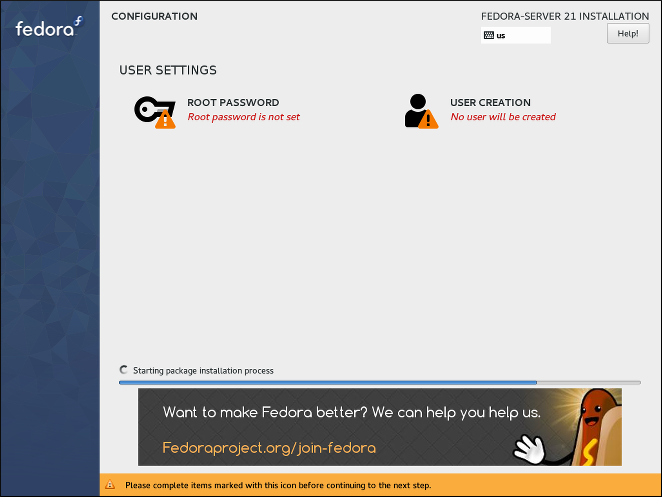
Ekranın üst kısmında, kimlik doğrulama ayarlarını yapılandırmanıza olanak tanıyan iki ek seçenek vardır - root parolası ve ek bir kullanıcı hesabı. Kurulumu tamamlamak için root parolasının yapılandırılması gereklidir; bir kullanıcı hesabı oluşturmak atlanabilir. Bunu yaparsanız, kurulum tamamlandıktan ve sisteminiz yeniden başlatıldıktan sonra sizden root olmayan bir kullanıcı hesabı oluşturmanız istenecektir.
Ekranın alt kısmında bir ilerleme çubuğu ve kurulumun o andaki ilerlemesini size bildiren bir mesaj gösterilir. Kurulum tamamlandığında ve root parolası ayarlandığında, bilgisayarınızı yeniden başlatmak ve yeni yüklenen Fedora sisteminizde oturum açmak için Yapılandırmayı bitir düğmesine basabilirsiniz.
|
Kurulumu bitirip yeniden başlatmadan önce, kurulumu başlatmak için kullandığınız ortamı (CD, DVD veya USB sürücü) çıkarın veya sisteminizin çıkarılabilir ortamı denemeden önce sabit sürücüden önyükleme yapmaya çalıştığından emin olun. Aksi takdirde, bilgisayarınız kurulu sistem yerine yeniden kurucuyu başlatacaktır. |
Root Parolası
Root Parolası ekranı, sisteminiz için root parolasını yapılandırmak için kullanılır. Bu parola yazılım paketlerinin kurulması ve güncellenmesi ile ağ ve güvenlik duvarı ayarları, depolama seçenekleri gibi sistem genelindeki yapılandırmaların değiştirilmesi ve kullanıcıların, grupların ve dosya izinlerinin eklenmesi ve değiştirilmesi gibi sistem yönetimi görevleri için kullanılan yönetici (süper kullanıcı olarak da bilinir) hesabında oturum açmak için kullanılacaktır.
root hesabı, kurulum sırasında her zaman oluşturulacaktır. Ancak, Kullanıcı Oluştur ekranında her zaman normal bir kullanıcı hesabı da oluşturmalı ve sistemde oturum açmak için bu hesabı kullanmalısınız. Yönetici hesabına yalnızca yönetici erişimi gerektiren bir görevi gerçekleştirmeniz gerektiğinde geçiş yapın.
|
|

Güçlü bir parola seçtikten sonra, bunu Root Parolası alanına girin. Yazdığınız karakterler güvenlik gerekçesiyle nokta olarak görüntülenecektir. Ardından, doğru bir şekilde girdiğinizden emin olmak için Onayla alanına aynı parolayı yazın. Girilen her iki parola da aynı olmalıdır.
Siz girerken parolanız değerlendirilecek ve kurucu parolanın sağlamlığını belirleyecektir. Kurucu parolanızın zayıf olduğunu düşünürse, ekranın alt kısmında seçtiğiniz parolanın hangi yönünün yetersiz olduğunu açıklayan bir mesaj görünecektir. Örneğin:
Sağladığınız parola zayıf:Parola 5 karakterden kısa.
Yukarıdakine benzer bir mesaj görünürse, farklı ve daha sağlam bir parola seçmeniz şiddetle tavsiye edilir.
Süper kullanıcı parolasını yapılandırdıktan sonra, Yapılandırma ve Kurulum İlerlemesi ekranına dönmek için sol üst köşedeki Bitti düğmesine tıklayın. Zayıf bir parola seçtiyseniz, düğmeye iki kez basmanız gerekir.
Kullanıcı Oluştur
Kullanıcı Oluştur ekranı, kurulum sırasında bir normal (root olmayan) kullanıcı hesabı oluşturmak ve yapılandırmak için kullanılabilir. Burada yalnızca bir kullanıcı hesabı yapılandırılabilir; daha fazla hesaba ihtiyacınız varsa kurulum tamamlanana kadar bekleyin, sisteminizi yeniden başlatın ve ardından bir terminalde useradd komutunu ya da kullanıcı hesaplarını yönetmek için bir grafiksel yardımcı programı (örneğin, GNOME Ayarlar menüsündeki Kullanıcılar ekranı) kullanarak diğer hesapları oluşturun.
|
Kurulumu bitirmek için normal bir kullanıcı hesabı oluşturmak gerekli değildir; ancak şiddetle tavsiye edilir. Eğer bir tane oluşturmazsanız, sistemde doğrudan |

Bir kullanıcı hesabı yapılandırmak için, Tam ad (örneğin, John Smith) ve Kullanıcı adı (örneğin, jsmith) alanlarını doldurun. Kullanıcı adı bir komut satırından oturum açmak için kullanılacaktır; bir grafiksel ortam kurarsanız, grafiksel oturum açma yöneticiniz Tam ad alanındaki değeri kullanacaktır.
Bu hesabı kullanmak için parola gerektir onay kutusunun işaretlendiğinden emin olun, bu hesap için kullanmak istediğiniz parolayı Parola alanına girin. Yazdığınız karakterler güvenlik gerekçesiyle nokta olarak görüntülenecektir. Ardından, doğru bir şekilde girdiğinizden emin olmak için aşağıdaki Parolayı onayla alanında aynı parolayı tekrarlayın. Girilen her iki parola da aynı olmalıdır.
Siz girerken parolanız değerlendirilecek ve kurucu parolanın sağlamlığını belirleyecektir. Kurucu parolanızın zayıf olduğunu düşünürse, ekranın alt kısmında seçtiğiniz parolanın hangi yönünün yetersiz olduğunu açıklayan bir mesaj görünecektir. Örneğin:
Sağladığınız parola zayıf:Parola 5 karakterden kısa.
Yukarıdakine benzer bir mesaj görünürse, farklı ve daha sağlam bir parola seçmeniz şiddetle tavsiye edilir.
Bu kullanıcıyı yönetici yap onay kutusu, oluşturduğunuz kullanıcıya (bu kullanıcıyı wheel grubuna ekleyerek) yönetici hakları verir, bu da bu kullanıcının root parolası yerine sadece kendi parolası ile normalde yalnızca root kullanıcısının yapabileceği görevleri gerçekleştirmek için sudo komutunu kullanmasına izin verir. Bunun kullanımı daha kolay olabilir, ancak aynı zamanda bir güvenlik riski de oluşturabilir.
|
Bir kullanıcıya yönetici ayrıcalıkları verirseniz, hesabın güçlü bir parola ile korunduğundan emin olun. Hesap için herhangi bir parola gerektirmeden bir kullanıcıya yönetici ayrıcalıkları vermeyin. Güçlü parolalar seçme yönergeleri dahil parola güvenliği hakkında ayrıntılı bilgi için https://docs.fedoraproject.org/ adresindeki Fedora Güvenlik Kılavuzuna bakın. |
Ek ayarlar için, parola giriş alanlarının altındaki Gelişmiş düğmesine tıklayın. Gelişmiş Kullanıcı Yapılandırma başlıklı yeni bir iletişim penceresi açılacaktır. Bu iletişim penceresi aşağıdaki bölümde açıklanmaktadır.
Gelişmiş Kullanıcı Yapılandırma
Gelişmiş Kullanıcı Yapılandırma iletişim penceresi, yeni kullanıcı hesabı için aşağıdaki ayarları değiştirmenize olanak tanır.
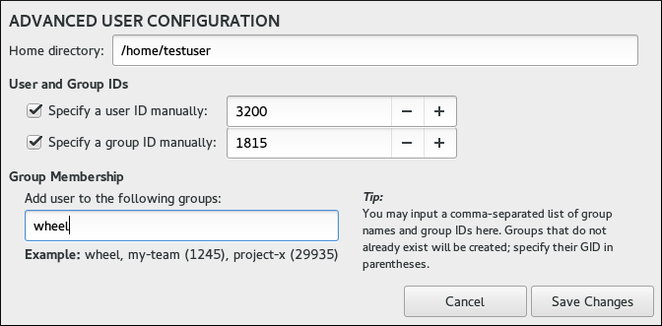
-
Kullanıcının
Ev dizini(öntanımlı olarak/home/kullanıcı-adı). -
Kullanıcının kimliği (UID). Öntanımlı değer 1000’dir. 0-999 arasındaki değerler sistem için ayrıldığından bir kullanıcıya atanamazlar.
-
Kullanıcının öntanımlı grubunun grup kimliği (GID). Öntanımlı grup adı, kullanıcı adıyla aynı olacaktır ve öntanımlı GID değeri 1000’dir. 0-999 arasındaki değerler sistem için ayrıldığından bir kullanıcının grubuna atanamazlar.
-
Kullanıcının grup üyeliği. Oluşturmakta olduğunuz kullanıcı hesabının her zaman bir öntanımlı grup üyeliği olacaktır (
Elle bir grup kimliği belirtinalanında kimliği ayarlanmış olan, kullanıcının öntanımlı grubu).Grup Üyeliğialanında, virgülle ayrılmış bir liste olarak ek grupları belirtebilirsiniz. Zaten var olmayan gruplar oluşturulacaktır; parantez içinde onlar için özel GID’ler belirtebilirsiniz. Yeni bir grup için özel bir GID belirtmezseniz, bu otomatik olarak atanacaktır.
Want to help? Learn how to contribute to Fedora Docs ›